Form generator/builder application for Django done right: customisable, modular, user- and developer- friendly.
Project description
django-fobi (or just fobi) is a customisable, modular, user- and developer- friendly form generator/builder application for Django. With fobi you can build Django forms using an intuitive GUI, save or mail posted form data or even export forms into JSON format and import them on other instances. API allows you to build your own form elements and form handlers (mechanisms for handling the submitted form data).






Prerequisites
Django 2.2, 3.0, 3.1, 3.2, 4.0 and 4.1.
Python 3.6, 3.7, 3.8, 3.9, 3.10 and 3.11.
Key concepts
Each form consists of elements. Form elements are divided into groups:
form fields (input field, textarea, hidden field, file field, etc.).
content (presentational) elements (text, image, embed video, etc.).
security elements (captcha, etc).
Number of form elements is not limited.
Each form may contain handlers. Handler processes the form data (for example, saves it or mails it). Number of the handlers is not limited.
Both form elements and form handlers are made with Django permission system in mind.
As an addition to form handlers, form callbacks are implemented. Form callbacks are fired on various stages of pre- and post-processing the form data (on POST). Form callbacks do not make use of permission system (unless you intentionally do so in the code of your callback) and are fired for all forms (unlike form handlers, that are executed only if assigned).
Each plugin (form element or form handler) or a callback - is a Django micro-app.
In addition for form element and form handler plugins, integration form element and integration form handler plugins are implemented for integration with diverse third-party apps and frameworks (such as Django REST framework).
Note, that django-fobi does not require django-admin and administrative rights/permissions to access the UI, although almost seamless integration with django-admin is implemented through the simple theme.
Main features and highlights
User-friendly GUI to quickly build forms.
Large variety of Bundled form element plugins. Most of the Django fields are supported. HTML5 fields are supported as well.
Form wizards. Combine your forms into wizards. Form wizards may contain handlers. Handler processes the form wizard data (for example, saves it or mails it). Number of the form wizard handlers is not limited.
Forms can be automatically enabled/disabled based on dates (start date, end date).
Anti-spam solutions like CAPTCHA, ReCAPTCHA, Honeypot or Invisible reCAPTCHA come out of the box (CAPTCHA and ReCAPTCHA do require additional third-party apps to be installed; Invisible reCAPTCHA doesn’t).
In addition to standard form elements, there are cosmetic (presentational) form elements (for adding a piece of text, image or a embed video) alongside standard form elements.
Data handling in plugins (form handlers). Save the data, mail it to some address or re-post it to some other endpoint. See the Bundled form handler plugins for more information.
Developer-friendly API, which allows to edit existing or build new form fields and handlers without touching the core.
Support for custom user model.
Class based views (and class-based permissions). Forms have an owner (auth.User). Default permissions are set for the owner, but class-based views provide a lot of freedom and can be easily customized.
Theming. There are 4 ready to use Bundled themes: “Bootstrap 3”, “Foundation 5”, “Simple” (with editing interface in style of Django admin) and “DjangoCMS admin style” theme (which is another simple theme with editing interface in style of djangocms-admin-style).
Implemented integration with Django REST framework.
Implemented integration with Wagtail (in a form of a Wagtail page).
Implemented integration with FeinCMS (in a form of a FeinCMS page widget).
Implemented integration with DjangoCMS (in a form of a DjangoCMS page plugin).
Implemented integration with Mezzanine (in a form of a Mezzanine page).
Reordering of form elements using drag-n-drop.
Data export (DB store form handler plugin) into XLS/CSV format.
Dynamic initial values for form elements.
Import/export forms to/from JSON format.
Import forms from MailChimp using mailchimp importer.
Roadmap
Some of the upcoming/in-development features/improvements are:
Implement disabling forms based on dates.
Cloning of forms.
JSON schema support.
Webpack integration.
Improved Django REST framework OPTIONS.
Bootstrap 5 support.
Foundation 6 support.
See the TODOS for the full list of planned-, pending- in-development- or to-be-implemented features.
Some screenshots
See the documentation for some screen shots:
Demo
Live demo
See the live demo app on Heroku. Additionally, see the Django REST framework integration demo.
Credentials:
username: test_user
password: test_user
Run demo locally
In order to be able to quickly evaluate the django-fobi, a demo app (with a quick installer) has been created (works on Ubuntu/Debian, may work on other Linux systems as well, although not guaranteed). Follow the instructions below for having the demo running within a minute.
Grab the latest django_fobi_example_app_installer.sh:
wget https://raw.github.com/barseghyanartur/django-fobi/stable/examples/django_fobi_example_app_installer.shAssign execute rights to the installer and run the django_fobi_example_app_installer.sh:
chmod +x django_fobi_example_app_installer.sh
./django_fobi_example_app_installer.shOpen your browser and test the app.
Dashboard:
Admin username: test_admin
Admin password: test
Django admin interface:
Admin username: test_admin
Admin password: test
If quick installer doesn’t work for you, see the manual steps on running the example project.
Quick start
See the quick start.
Installation
Install latest stable version from PyPI:
pip install django-fobiOr latest stable version from GitHub:
pip install https://github.com/barseghyanartur/django-fobi/archive/stable.tar.gzAdd fobi to INSTALLED_APPS of the your projects’ Django settings. Furthermore, all themes and plugins to be used, shall be added to the INSTALLED_APPS as well. Note, that if a plugin has additional dependencies, you should be mentioning those in the INSTALLED_APPS as well.
INSTALLED_APPS = ( # Used by fobi 'django.contrib.auth', 'django.contrib.contenttypes', 'django.contrib.sessions', 'django.contrib.sites', 'django.contrib.messages', 'django.contrib.staticfiles', 'django.contrib.admin', # ... # `django-fobi` core 'fobi', # `django-fobi` themes 'fobi.contrib.themes.bootstrap3', # Bootstrap 3 theme 'fobi.contrib.themes.foundation5', # Foundation 5 theme 'fobi.contrib.themes.simple', # Simple theme # `django-fobi` form elements - fields 'fobi.contrib.plugins.form_elements.fields.boolean', 'fobi.contrib.plugins.form_elements.fields.checkbox_select_multiple', 'fobi.contrib.plugins.form_elements.fields.date', 'fobi.contrib.plugins.form_elements.fields.date_drop_down', 'fobi.contrib.plugins.form_elements.fields.datetime', 'fobi.contrib.plugins.form_elements.fields.decimal', 'fobi.contrib.plugins.form_elements.fields.email', 'fobi.contrib.plugins.form_elements.fields.file', 'fobi.contrib.plugins.form_elements.fields.float', 'fobi.contrib.plugins.form_elements.fields.hidden', 'fobi.contrib.plugins.form_elements.fields.input', 'fobi.contrib.plugins.form_elements.fields.integer', 'fobi.contrib.plugins.form_elements.fields.ip_address', 'fobi.contrib.plugins.form_elements.fields.null_boolean', 'fobi.contrib.plugins.form_elements.fields.password', 'fobi.contrib.plugins.form_elements.fields.radio', 'fobi.contrib.plugins.form_elements.fields.regex', 'fobi.contrib.plugins.form_elements.fields.select', 'fobi.contrib.plugins.form_elements.fields.select_model_object', 'fobi.contrib.plugins.form_elements.fields.select_multiple', 'fobi.contrib.plugins.form_elements.fields.select_multiple_model_objects', 'fobi.contrib.plugins.form_elements.fields.slug', 'fobi.contrib.plugins.form_elements.fields.text', 'fobi.contrib.plugins.form_elements.fields.textarea', 'fobi.contrib.plugins.form_elements.fields.time', 'fobi.contrib.plugins.form_elements.fields.url', # `django-fobi` form elements - content elements 'fobi.contrib.plugins.form_elements.test.dummy', 'easy_thumbnails', # Required by `content_image` plugin 'fobi.contrib.plugins.form_elements.content.content_image', 'fobi.contrib.plugins.form_elements.content.content_image_url', 'fobi.contrib.plugins.form_elements.content.content_text', 'fobi.contrib.plugins.form_elements.content.content_video', # `django-fobi` form handlers 'fobi.contrib.plugins.form_handlers.db_store', 'fobi.contrib.plugins.form_handlers.http_repost', 'fobi.contrib.plugins.form_handlers.mail', 'fobi.contrib.plugins.form_handlers.mail_sender', # Other project specific apps 'foo', # Test app # ... )Make appropriate changes to the TEMPLATES of the your projects’ Django settings.
And fobi.context_processors.theme and fobi.context_processors.dynamic_values. See the following example.
TEMPLATES = [ { 'BACKEND': 'django.template.backends.django.DjangoTemplates', 'DIRS': [(os.path.join('path', 'to', 'your', 'templates'))], 'OPTIONS': { 'context_processors': [ "django.template.context_processors.debug", 'django.template.context_processors.request', "django.contrib.auth.context_processors.auth", "django.contrib.messages.context_processors.messages", "fobi.context_processors.theme", # Important! "fobi.context_processors.dynamic_values", # Optional ], 'loaders': [ 'django.template.loaders.filesystem.Loader', 'django.template.loaders.app_directories.Loader', 'admin_tools.template_loaders.Loader', ], 'debug': DEBUG_TEMPLATE, } }, ]Make sure that django.core.context_processors.request is in context_processors too.
Configure URLs
Add the following line to urlpatterns of your urls module.
# View URLs re_path(r'^fobi/', include('fobi.urls.class_based.view')), # Edit URLs re_path(r'^fobi/', include('fobi.urls.class_based.edit')),Note, that some plugins require additional URL includes. For instance, if you listed the fobi.contrib.plugins.form_handlers.db_store form handler plugin in the INSTALLED_APPS, you should mention the following in urls module.
# DB Store plugin URLs re_path(r'^fobi/plugins/form-handlers/db-store/', include('fobi.contrib.plugins.form_handlers.db_store.urls')),
View URLs are put separately from edit URLs in order to make it possible to prefix the edit URLs differently. For example, if you’re using the “Simple” theme, you would likely want to prefix the edit URLs with “admin/” so that it looks more like django-admin.
Creating a new form element plugin
Form element plugins represent the elements of which the forms is made: Inputs, checkboxes, textareas, files, hidden fields, as well as pure presentational elements (text or image). Number of form elements in a form is not limited.
Presentational form elements are inherited from fobi.base.FormElementPlugin.
The rest (real form elements, that are supposed to have a value) are inherited from fobi.base.FormFieldPlugin.
You should see a form element plugin as a Django micro app, which could have its’ own models, admin interface, etc.
django-fobi comes with several bundled form element plugins. Do check the source code as example.
Let’s say, you want to create a textarea form element plugin.
There are several properties, each textarea should have. They are:
label (string): HTML label of the textarea.
name (string): HTML name of the textarea.
initial (string): Initial value of the textarea.
required (bool): Flag, which tells us whether the field is required or optional.
Let’s name that plugin sample_textarea. The plugin directory should then have the following structure.
path/to/sample_textarea/
├── __init__.py
├── fobi_form_elements.py # Where plugins are defined and registered
├── forms.py # Plugin configuration form
└── widgets.py # Where plugins widgets are definedForm element plugins should be registered in “fobi_form_elements.py” file. Each plugin module should be put into the INSTALLED_APPS of your Django projects’ settings.
In some cases, you would need plugin specific overridable settings (see fobi.contrib.form_elements.fields.content.content_image plugin as an example). You are advised to write your settings in such a way, that variables of your Django project settings module would have FOBI_PLUGIN_ prefix.
Define and register the form element plugin
Step by step review of a how to create and register a plugin and plugin widgets. Note, that django-fobi auto-discovers your plugins if you place them into a file named fobi_form_elements.py of any Django app listed in INSTALLED_APPS of your Django projects’ settings module.
path/to/sample_textarea/fobi_form_elements.py
A single form element plugin is registered by its’ UID.
Required imports.
from django import forms
from fobi.base import FormFieldPlugin, form_element_plugin_registry
from path.to.sample_textarea.forms import SampleTextareaFormDefining the Sample textarea plugin.
class SampleTextareaPlugin(FormFieldPlugin):
"""Sample textarea plugin."""
uid = "sample_textarea"
name = "Sample Textarea"
form = SampleTextareaForm
group = "Samples" # Group to which the plugin belongs to
def get_form_field_instances(self,
request=None,
form_entry=None,
form_element_entries=None,
**kwargs):
kwargs = {
'required': self.data.required,
'label': self.data.label,
'initial': self.data.initial,
'widget': forms.widgets.Textarea(attrs={})
}
return [(self.data.name, forms.CharField, kwargs),]Registering the SampleTextareaPlugin plugin.
form_element_plugin_registry.register(SampleTextareaPlugin)Note, that in case you want to define a pure presentational element, make use of fobi.base.FormElementPlugin for subclassing, instead of fobi.base.FormFieldPlugin. See the source of the content plugins (fobi.contrib.plugins.form_elements.content) as a an example.
For instance, the captcha and honeypot fields are implemented as form elements (subclasses the fobi.base.FormElementPlugin). The db_store form handler plugin does not save the form data of those elements. If you want the form element data to be saved, do inherit from fobi.base.FormFieldPlugin.
Hidden form element plugins, should be also having set the is_hidden property to True. By default it’s set to False. That makes the hidden form elements to be rendered using as django.forms.widgets.TextInput widget in edit mode. In the view mode, the original widget that you assigned in your form element plugin would be used.
There might be cases, when you need to do additional handling of the data upon the successful form submission. In such cases, you will need to define a submit_plugin_form_data method in the plugin, which accepts the following arguments:
form_entry (fobi.models.FormEntry): Form entry, which is being submitted.
request (django.http.HttpRequest): The Django HTTP request.
form (django.forms.Form): Form object (a valid one, which contains the cleaned_data attribute).
form_element_entries (fobi.models.FormElementEntry): Form element entries for the form_entry given.
(**)kwargs : Additional arguments.
Example (taken from fobi.contrib.plugins.form_elements.fields.file):
def submit_plugin_form_data(self,
form_entry,
request,
form,
form_element_entries=None,
**kwargs):
"""Submit plugin form data."""
# Get the file path
file_path = form.cleaned_data.get(self.data.name, None)
if file_path:
# Handle the upload
saved_file = handle_uploaded_file(FILES_UPLOAD_DIR, file_path)
# Overwrite ``cleaned_data`` of the ``form`` with path to moved
# file.
form.cleaned_data[self.data.name] = "{0}{1}".format(
settings.MEDIA_URL, saved_file
)
# It's critically important to return the ``form`` with updated
# ``cleaned_data``
return formIn the example below, the original form is being modified. If you don’t want the original form to be modified, do not return anything.
Check the file form element plugin (fobi.contrib.plugins.form_elements.fields.file) for complete example.
path/to/sample_textarea/forms.py
Why to have another file for defining forms? Just to keep the code clean and less messy, although you could perfectly define all your plugin forms in the module fobi_form_elements.py, it’s recommended to keep it separate.
Take into consideration, that forms.py is not an auto-discovered file pattern. All your form element plugins should be registered in modules named fobi_form_elements.py.
Required imports.
from django import forms
from fobi.base import BasePluginFormForm for for SampleTextareaPlugin form element plugin.
class SampleTextareaForm(forms.Form, BasePluginForm):
"""Sample textarea form."""
plugin_data_fields = [
("name", ""),
("label", ""),
("initial", ""),
("required", False)
]
name = forms.CharField(label="Name", required=True)
label = forms.CharField(label="Label", required=True)
initial = forms.CharField(label="Initial", required=False)
required = forms.BooleanField(label="Required", required=False)Note that although it’s not being checked in the code, but for form field plugins the following fields should be present in the plugin form (BasePluginForm) and the form plugin (FormFieldPlugin):
name
In some cases, you might want to do something with the data before it gets saved. For that purpose, save_plugin_data method has been introduced.
See the following example.
def save_plugin_data(self, request=None):
"""Saving the plugin data and moving the file."""
file_path = self.cleaned_data.get('file', None)
if file_path:
saved_image = handle_uploaded_file(IMAGES_UPLOAD_DIR, file_path)
self.cleaned_data['file'] = saved_imagepath/to/sample_textarea/widgets.py
Required imports.
from fobi.base import FormElementPluginWidgetDefining the base plugin widget.
class BaseSampleTextareaPluginWidget(FormElementPluginWidget):
"""Base sample textarea plugin widget."""
# Same as ``uid`` value of the ``SampleTextareaPlugin``.
plugin_uid = "sample_textarea"path/to/sample_layout/fobi_form_elements.py
Register in the registry (in some module which is for sure to be loaded; it’s handy to do it in the theme module).
Required imports.
from fobi.base import form_element_plugin_widget_registry
from path.to.sample_textarea.widgets import BaseSampleTextareaPluginWidgetDefine the theme specific plugin.
class SampleTextareaPluginWidget(BaseSampleTextareaPluginWidget):
"""Sample textarea plugin widget."""
theme_uid = 'bootstrap3' # Theme for which the widget is loaded
media_js = [
'sample_layout/js/fobi.plugins.form_elements.sample_textarea.js',
]
media_css = [
'sample_layout/css/fobi.plugins.form_elements.sample_textarea.css',
]Register the widget.
form_element_plugin_widget_registry.register(SampleTextareaPluginWidget)Form element plugin final steps
Now, that everything is ready, make sure your plugin module is added to INSTALLED_APPS.
INSTALLED_APPS = (
# ...
'path.to.sample_textarea',
# ...
)Afterwards, go to terminal and type the following command.
./manage.py fobi_sync_pluginsIf your HTTP server is running, you would then be able to see the new plugin in the edit form interface.
Dashboard URL: http://127.0.0.1:8000/fobi/
Note, that you have to be logged in, in order to use the dashboard. If your new plugin doesn’t appear, set the FOBI_DEBUG to True in your Django’s local settings module, re-run your code and check console for error notifications.
Creating a new form handler plugin
Form handler plugins handle the form data. django-fobi comes with several bundled form handler plugins, among which is the db_store and mail plugins, which are responsible for saving the submitted form data into the database and mailing the data to recipients specified. Number of form handlers in a form is not limited. Certain form handlers are not configurable (for example the db_store form handler isn’t), while others are (mail, http_repost).
You should see a form handler as a Django micro app, which could have its’ own models, admin interface, etc.
By default, it’s possible to use a form handler plugin multiple times per form. If you wish to allow form handler plugin to be used only once in a form, set the allow_multiple property of the plugin to False.
As said above, django-fobi comes with several bundled form handler plugins. Do check the source code as example.
Define and register the form handler plugin
Let’s name that plugin sample_mail. The plugin directory should then have the following structure.
path/to/sample_mail/
├── __init__.py
├── fobi_form_handlers.py # Where plugins are defined and registered
└── forms.py # Plugin configuration formForm handler plugins should be registered in “fobi_form_handlers.py” file. Each plugin module should be put into the INSTALLED_APPS of your Django projects’ settings.
path/to/sample_mail/fobi_form_handlers.py
A single form handler plugin is registered by its’ UID.
Required imports.
import json
from django.core.mail import send_mail
from fobi.base import FormHandlerPlugin, form_handler_plugin_registry
from path.to.sample_mail.forms import SampleMailFormDefining the Sample mail handler plugin.
class SampleMailHandlerPlugin(FormHandlerPlugin):
"""Sample mail handler plugin."""
uid = "sample_mail"
name = _("Sample mail")
form = SampleMailForm
def run(self, form_entry, request, form, form_element_entries=None):
"""To be executed by handler."""
send_mail(
self.data.subject,
json.dumps(form.cleaned_data),
self.data.from_email,
[self.data.to_email],
fail_silently=True
)Register the plugin
form_handler_plugin_registry.register(SampleMailHandlerPlugin)Some form handlers are configurable, some others not. In order to have a user friendly way of showing the form handler settings, what’s sometimes needed, a plugin_data_repr method has been introduced. Simplest implementation of it would look as follows:
def plugin_data_repr(self):
"""Human readable representation of plugin data.
:return string:
"""
return self.data.__dict__path/to/sample_mail/forms.py
If plugin is configurable, it has configuration data. A single form may have unlimited number of same plugins. Imagine, you want to have different subjects and additional body texts for different user groups. You could then assign two form handler mail plugins to the form. Of course, saving the posted form data many times does not make sense, but it’s up to the user. So, in case if plugin is configurable, it should have a form.
Why to have another file for defining forms? Just to keep the code clean and less messy, although you could perfectly define all your plugin forms in the module fobi_form_handlers.py, it’s recommended to keep it separate.
Take into consideration, that forms.py is not an auto-discovered file pattern. All your form handler plugins should be registered in modules named fobi_form_handlers.py.
Required imports.
from django import forms
from django.utils.translation import gettext_lazy as _
from fobi.base import BasePluginFormDefining the form for Sample mail handler plugin.
class MailForm(forms.Form, BasePluginForm):
"""Mail form."""
plugin_data_fields = [
("from_name", ""),
("from_email", ""),
("to_name", ""),
("to_email", ""),
("subject", ""),
("body", ""),
]
from_name = forms.CharField(label=_("From name"), required=True)
from_email = forms.EmailField(label=_("From email"), required=True)
to_name = forms.CharField(label=_("To name"), required=True)
to_email = forms.EmailField(label=_("To email"), required=True)
subject = forms.CharField(label=_("Subject"), required=True)
body = forms.CharField(
label=_("Body"),
required=False,
widget=forms.widgets.Textarea
)After the plugin has been processed, all its’ data is available in a plugin_instance.data container (for example, plugin_instance.data.subject or plugin_instance.data.from_name).
Prioritise the execution order
Some form handlers shall be executed prior others. A good example of such, is a combination of “mail” and “db_save” form handlers for the form. In case if large files are posted, submission of form data would fail if “mail” plugin would be executed after “db_save” has been executed. That’s why it’s possible to prioritise that ordering in a FOBI_FORM_HANDLER_PLUGINS_EXECUTION_ORDER setting variable.
If not specified or left empty, form handler plugins would be ran in the order of discovery. All form handler plugins that are not listed in the FORM_HANDLER_PLUGINS_EXECUTION_ORDER, would be ran after the plugins that are mentioned there.
FORM_HANDLER_PLUGINS_EXECUTION_ORDER = (
'http_repost',
'mail',
# The 'db_store' is left out intentionally, since it should
# be the last plugin to be executed.
)Form handler plugin custom actions
By default, a single form handler plugin has at least a “delete” action. If plugin is configurable, it gets an “edit” action as well.
For some of your plugins, you may want to register a custom action. For example, the “db_store” plugin does have one, for showing a link to a listing page with saved form data for the form given.
For such cases, define a custom_actions method in your form handler plugin. That method shall return a list of triples. In each triple, first value is the URL, second value is the title and the third value is the icon of the URL.
The following example is taken from the “db_store” plugin.
def custom_actions(self):
"""Adding a link to view the saved form entries.
:return iterable:
"""
return (
(
reverse('fobi.contrib.plugins.form_handlers.db_store.view_saved_form_data_entries'),
_("View entries"),
'glyphicon glyphicon-list'
),
)Form handler plugin final steps
Do not forget to add the form handler plugin module to INSTALLED_APPS.
INSTALLED_APPS = (
# ...
'path.to.sample_mail',
# ...
)Afterwards, go to terminal and type the following command.
./manage.py fobi_sync_pluginsIf your HTTP server is running, you would then be able to see the new plugin in the edit form interface.
Creating a new form importer plugin
Form importer plugins import the forms from some external data source into django-fobi form format. Number of form importers is not limited. Form importers are implemented in forms of wizards (since they may contain several steps).
You should see a form importer as a Django micro app, which could have its’ own models, admin interface, etc.
At the moment django-fobi comes with only one bundled form handler plugin, which is the mailchimp_importer, which is responsible for importing existing MailChimp forms into django-fobi.
Define and register the form importer plugin
Let’s name that plugin sample_importer. The plugin directory should then have the following structure.
path/to/sample_importer/
├── templates
│ └── sample_importer
│ ├── 0.html
│ └── 1.html
├── __init__.py
├── fobi_form_importers.py # Where plugins are defined and registered
├── forms.py # Wizard forms
└── views.py # Wizard viewsForm importer plugins should be registered in “fobi_form_importers.py” file. Each plugin module should be put into the INSTALLED_APPS of your Django projects’ settings.
path/to/sample_importer/fobi_form_importers.py
A single form importer plugin is registered by its’ UID.
Required imports.
from django.utils.translation import gettext_lazy as _
from fobi.form_importers import BaseFormImporter, form_importer_plugin_registry
from fobi.contrib.plugins.form_elements import fields
from path.to.sample_importer.views import SampleImporterWizardViewDefining the Sample importer plugin.
class SampleImporterPlugin(FormHandlerPlugin):
"""Sample importer plugin."""
uid = 'sample_importer'
name = _("Sample importer")
wizard = SampleImporterWizardView
templates = [
'sample_importer/0.html',
'sample_importer/1.html',
]
# field_type (at importer): uid (django-fobi)
fields_mapping = {
# Implemented
'email': fields.email.UID,
'text': fields.text.UID,
'number': fields.integer.UID,
'dropdown': fields.select.UID,
'date': fields.date.UID,
'url': fields.url.UID,
'radio': fields.radio.UID,
# Transformed into something else
'address': fields.text.UID,
'zip': fields.text.UID,
'phone': fields.text.UID,
}
# Django standard: remote
field_properties_mapping = {
'label': 'name',
'name': 'tag',
'help_text': 'helptext',
'initial': 'default',
'required': 'req',
'choices': 'choices',
}
field_type_prop_name = 'field_type'
position_prop_name = 'order'
def extract_field_properties(self, field_data):
field_properties = {}
for prop, val in self.field_properties_mapping.items():
if val in field_data:
if 'choices' == val:
field_properties[prop] = "\n".join(field_data[val])
else:
field_properties[prop] = field_data[val]
return field_properties
form_importer_plugin_registry.register(SampleImporter)path/to/sample_importer/forms.py
As mentioned above, form importers are implemented in form of wizards. The forms are the wizard steps.
Required imports.
from django import forms
from django.utils.translation import gettext_lazy as _
from sample_service_api import sample_api # Just an imaginary API clientDefining the form for Sample importer plugin.
class SampleImporterStep1Form(forms.Form):
"""First form the the wizard."""
api_key = forms.CharField(required=True)
class SampleImporterStep2Form(forms.Form):
"""Second form of the wizard."""
list_id = forms.ChoiceField(required=True, choices=[])
def __init__(self, *args, **kwargs):
self._api_key = None
if 'api_key' in kwargs:
self._api_key = kwargs.pop('api_key', None)
super(SampleImporterStep2Form, self).__init__(*args, **kwargs)
if self._api_key:
client = sample_api.Api(self._api_key)
lists = client.lists.list()
choices = [(l['id'], l['name']) for l in lists['data']]
self.fields['list_id'].choices = choicespath/to/sample_importer/views.py
The wizard views.
Required imports.
from sample_service_api import sample_api # Just an imaginary API client
from django.shortcuts import redirect
from django.urls import reverse
from django.contrib import messages
from django.utils.translation import gettext_lazy as _
# For django LTE 1.8 import from `django.contrib.formtools.wizard.views`
from formtools.wizard.views import SessionWizardView
from path.to.sample_importer.forms import (
SampleImporterStep1Form,
SampleImporterStep2Form,
)Defining the wizard view for Sample importer plugin.
class SampleImporterWizardView(SessionWizardView):
"""Sample importer wizard view."""
form_list = [SampleImporterStep1Form, SampleImporterStep2Form]
def get_form_kwargs(self, step):
"""Get form kwargs (to be used internally)."""
if '1' == step:
data = self.get_cleaned_data_for_step('0') or {}
api_key = data.get('api_key', None)
return {'api_key': api_key}
return {}
def done(self, form_list, **kwargs):
"""After all forms are submitted."""
# Merging cleaned data into one dict
cleaned_data = {}
for form in form_list:
cleaned_data.update(form.cleaned_data)
# Connecting to sample client API
client = sample_client.Api(cleaned_data['api_key'])
# Fetching the form data
form_data = client.lists.merge_vars(
id={'list_id': cleaned_data['list_id']}
)
# We need the first form only
try:
form_data = form_data['data'][0]
except Exception as err:
messages.warning(
self.request,
_('Selected form could not be imported due errors.')
)
return redirect(reverse('fobi.dashboard'))
# Actually, import the form
form_entry = self._form_importer.import_data(
{'name': form_data['name'], 'user': self.request.user},
form_data['merge_vars']
)
redirect_url = reverse(
'fobi.edit_form_entry',
kwargs={'form_entry_id': form_entry.pk}
)
messages.info(
self.request,
_('Form {0} imported successfully.').format(form_data['name'])
)
return redirect("{0}".format(redirect_url))Form importer plugin final steps
Do not forget to add the form importer plugin module to INSTALLED_APPS.
INSTALLED_APPS = (
# ...
'path.to.sample_importer',
# ...
)Afterwards, go to terminal and type the following command.
./manage.py fobi_sync_pluginsIf your HTTP server is running, you would then be able to see the new plugin in the dashboard form interface (implemented in all bundled themes).
Creating a form callback
Form callbacks are additional hooks, that are executed on various stages of the form submission.
Let’s place the callback in the foo module. The plugin directory should then have the following structure.
path/to/foo/
├── __init__.py
└── fobi_form_callbacks.py # Where callbacks are defined and registeredSee the callback example below.
Required imports.
from fobi.constants import (
CALLBACK_BEFORE_FORM_VALIDATION,
CALLBACK_FORM_VALID_BEFORE_SUBMIT_PLUGIN_FORM_DATA,
CALLBACK_FORM_VALID,
CALLBACK_FORM_VALID_AFTER_FORM_HANDLERS,
CALLBACK_FORM_INVALID,
)
from fobi.base import FormCallback, form_callback_registryDefine and register the callback
class SampleFooCallback(FormCallback):
"""Sample foo callback."""
stage = CALLBACK_FORM_VALID
def callback(self, form_entry, request, form):
"""Define your callback code here."""
print("Great! Your form is valid!")
form_callback_registry.register(SampleFooCallback)Add the callback module to INSTALLED_APPS.
INSTALLED_APPS = (
# ...
'path.to.foo',
# ...
)Class-based views
Views
Migration to class based views is simple. Only your project’s urls.py would change:
urlpatterns = [
# ...
re_path(r'^fobi/', include('fobi.urls.class_based.view')),
re_path(r'^fobi/', include('fobi.urls.class_based.edit')),
# ...
]To use function based views, simply replace the previous line with:
urlpatterns = [
# ...
re_path(r'^fobi/', include('fobi.urls.view')),
re_path(r'^fobi/', include('fobi.urls.edit')),
# ...
]Permissions
Class-based permissions work only in combination with class-based views.
Example:
from fobi.permissions.definitions import edit_form_entry_permissions
from fobi.permissions.generic import BasePermission
from fobi.permissions.helpers import (
any_permission_required_func, login_required,
)
class EditFormEntryPermission(BasePermission):
"""Permission to edit form entries."""
def has_permission(self, request, view) -> bool:
return login_required(request) and any_permission_required_func(
edit_form_entry_permissions
)(request.user)
def has_object_permission(self, request, view, obj) -> bool:
return login_required(request) and any_permission_required_func(
edit_form_entry_permissions
)(request.user) and obj.user == request.userAnd then in your view:
from fobi.views.class_based import EditFormEntryView
class MyEditFormEntryView(EditFormEntryView):
"""EditFormEntryView."""
permission_classes = (EditFormEntryPermission,)Suggestions
Custom action for the form
Sometimes, you would want to specify a different action for the form. Although it’s possible to define a custom form action (action field in the “Form properties” tab), you’re advised to use the http_repost plugin instead, since then the form would be still validated locally and only then the valid data, as is, would be sent to the desired endpoint.
Take in mind, that if both cases, if CSRF protection is enabled on the endpoint, your post request would result an error.
When you want to customise too many things
django-fobi, with its’ flexible form elements, form handlers and form callbacks is very customisable. However, there might be cases when you need to override entire view to fit your needs. Take a look at the FeinCMS integration or DjangoCMS integration as a good example of such. You may also want to compare the code from original view fobi.views.view_form_entry with the code from the widget to get a better idea of what could be changed in your case. If need a good advice, just ask me.
Theming
django-fobi comes with theming API. While there are several ready-to-use themes:
“Bootstrap 3” theme
“Foundation 5” theme
“Simple” theme in (with editing interface in style of the Django admin)
“DjangoCMS admin style” theme (which is another simple theme with editing interface in style of djangocms-admin-style)
Obviously, there are two sorts of views when it comes to editing and viewing the form.
The “view-view”, when the form as it has been made is exposed to the site end- users/visitors.
The “edit-view” (builder view), where the authorised users build their forms.
Both “Bootstrap 3” and “Foundation 5” themes are making use of the same style for both “view-view” and “edit-view” views.
Both “Simple” and “DjangoCMS admin style” themes are styling for the “edit-view” only. The “view-view” is pretty much blank, as shown on the one of the screenshots [2.6].
Have in mind, that creating a brand new theme could be time consuming. Instead, you are advised to extend existing themes or in the worst case, if too much customisation required, create your own themes based on existing ones (just copy the desired theme to your project directory and work it out further).
It’s possible to use different templates for all “view” and “edit” actions (see the source code of the “simple” theme). Both “Bootstrap 3” and “Foundation 5” themes look great. Although if you can’t use any of those, the “Simple” theme is the best start, since it looks just like django-admin.
Create a new theme
Let’s place the theme in the sample_theme module. The theme directory should then have the following structure.
path/to/sample_theme/
├── static
│ ├── css
│ │ └── sample_theme.css
│ └── js
│ └── sample_theme.js
├── templates
│ └── sample_theme
│ ├── _base.html
│ ├── add_form_element_entry.html
│ ├── ...
│ └── view_form_entry_ajax.html
├── __init__.py
├── fobi_form_elements.py
└── fobi_themes.py # Where themes are defined and registeredSee the theme example below.
from django.utils.translation import gettext_lazy as _
from fobi.base import BaseTheme, theme_registry
class SampleTheme(BaseTheme):
"""Sample theme."""
uid = 'sample'
name = _("Sample")
media_css = (
'sample_theme/css/sample_theme.css',
'css/fobi.core.css',
)
media_js = (
'js/jquery-1.10.2.min.js',
'jquery-ui/js/jquery-ui-1.10.3.custom.min.js',
'js/jquery.slugify.js',
'js/fobi.core.js',
'sample_theme/js/sample_theme.js',
)
# Form element specific
form_element_html_class = 'form-control'
form_radio_element_html_class = 'radio'
form_element_checkbox_html_class = 'checkbox'
form_edit_form_entry_option_class = 'glyphicon glyphicon-edit'
form_delete_form_entry_option_class = 'glyphicon glyphicon-remove'
form_list_container_class = 'list-inline'
# Templates
master_base_template = 'sample_theme/_base.html'
base_template = 'sample_theme/base.html'
form_ajax = 'sample_theme/snippets/form_ajax.html'
form_snippet_template_name = 'sample_theme/snippets/form_snippet.html'
form_properties_snippet_template_name = 'sample_theme/snippets/form_properties_snippet.html'
messages_snippet_template_name = 'sample_theme/snippets/messages_snippet.html'
add_form_element_entry_template = 'sample_theme/add_form_element_entry.html'
add_form_element_entry_ajax_template = 'sample_theme/add_form_element_entry_ajax.html'
add_form_handler_entry_template = 'sample_theme/add_form_handler_entry.html'
add_form_handler_entry_ajax_template = 'sample_theme/add_form_handler_entry_ajax.html'
create_form_entry_template = 'sample_theme/create_form_entry.html'
create_form_entry_ajax_template = 'bootstrap3/create_form_entry_ajax.html'
dashboard_template = 'sample_theme/dashboard.html'
edit_form_element_entry_template = 'sample_theme/edit_form_element_entry.html'
edit_form_element_entry_ajax_template = 'sample_theme/edit_form_element_entry_ajax.html'
edit_form_entry_template = 'sample_theme/edit_form_entry.html'
edit_form_entry_ajax_template = 'sample_theme/edit_form_entry_ajax.html'
edit_form_handler_entry_template = 'sample_theme/edit_form_handler_entry.html'
edit_form_handler_entry_ajax_template = 'sample_theme/edit_form_handler_entry_ajax.html'
form_entry_submitted_template = 'sample_theme/form_entry_submitted.html'
form_entry_submitted_ajax_template = 'sample_theme/form_entry_submitted_ajax.html'
view_form_entry_template = 'sample_theme/view_form_entry.html'
view_form_entry_ajax_template = 'sample_theme/view_form_entry_ajax.html'Registering the SampleTheme plugin.
theme_registry.register(SampleTheme)Sometimes you would want to attach additional properties to the theme in order to use them later in templates (remember, current theme object is always available in templates under name fobi_theme).
For such cases you would need to define a variable in your project’s settings module, called FOBI_CUSTOM_THEME_DATA. See the following code as example:
# `django-fobi` custom theme data for to be displayed in third party apps
# like `django-registraton`.
FOBI_CUSTOM_THEME_DATA = {
'bootstrap3': {
'page_header_html_class': '',
'form_html_class': 'form-horizontal',
'form_button_outer_wrapper_html_class': 'control-group',
'form_button_wrapper_html_class': 'controls',
'form_button_html_class': 'btn',
'form_primary_button_html_class': 'btn-primary pull-right',
},
'foundation5': {
'page_header_html_class': '',
'form_html_class': 'form-horizontal',
'form_button_outer_wrapper_html_class': 'control-group',
'form_button_wrapper_html_class': 'controls',
'form_button_html_class': 'radius button',
'form_primary_button_html_class': 'btn-primary',
},
'simple': {
'page_header_html_class': '',
'form_html_class': 'form-horizontal',
'form_button_outer_wrapper_html_class': 'control-group',
'form_button_wrapper_html_class': 'submit-row',
'form_button_html_class': 'btn',
'form_primary_button_html_class': 'btn-primary',
}
}You would now be able to access the defined extra properties in templates as shown below.
<div class="{{ fobi_theme.custom_data.form_button_wrapper_html_class }}">You likely would want to either remove the footer text or change it. Define a variable in your project’s settings module, called FOBI_THEME_FOOTER_TEXT. See the following code as example:
FOBI_THEME_FOOTER_TEXT = gettext('© django-fobi example site 2014')Below follow the properties of the theme:
base_edit
base_view
There are generic templates made in order to simplify theming. Some of them you would never need to override. Some others, you would likely want to.
Templates that you likely would want to re-write in your custom theme implementation are marked with three asterisks (***):
generic
├── snippets
│ ├── form_ajax.html
│ ├── form_edit_ajax.html
│ ├── *** form_properties_snippet.html
│ ├── *** form_snippet.html
│ ├── --- form_edit_snippet.html (does not exist in generic templates)
│ ├── --- form_view_snippet.html (does not exist in generic templates)
│ ├── form_view_ajax.html
│ └── messages_snippet.html
│
├── _base.html
├── add_form_element_entry.html
├── add_form_element_entry_ajax.html
├── add_form_handler_entry.html
├── add_form_handler_entry_ajax.html
├── base.html
├── create_form_entry.html
├── create_form_entry_ajax.html
├── *** dashboard.html
├── edit_form_element_entry.html
├── edit_form_element_entry_ajax.html
├── edit_form_entry.html
├── *** edit_form_entry_ajax.html
├── edit_form_handler_entry.html
├── edit_form_handler_entry_ajax.html
├── form_entry_submitted.html
├── *** form_entry_submitted_ajax.html
├── *** theme.html
├── view_form_entry.html
└── view_form_entry_ajax.htmlFrom all of the templates listed above, the _base.html template is the most influenced by the Bootstrap 3 theme.
Make changes to an existing theme
As said above, making your own theme from scratch could be costly. Instead, you can override/reuse an existing one and change it to your needs with minimal efforts. See the override simple theme example. In order to see it in action, run the project with settings_override_simple_theme option:
./manage.py runserver --settings=settings_override_simple_themeDetails explained below.
Directory structure
override_simple_theme/
├── static
│ └── override_simple_theme
│ ├── css
│ │ └── override-simple-theme.css
│ └── js
│ └── override-simple-theme.js
│
├── templates
│ └── override_simple_theme
│ ├── snippets
│ │ └── form_ajax.html
│ └── base_view.html
├── __init__.py
└── fobi_themes.py # Where themes are defined and registeredfobi_themes.py
Overriding the “simple” theme.
__all__ = ('MySimpleTheme',)
from fobi.base import theme_registry
from fobi.contrib.themes.simple.fobi_themes import SimpleTheme
class MySimpleTheme(SimpleTheme):
"""My simple theme, inherited from `SimpleTheme` theme."""
html_classes = ['my-simple-theme',]
base_view_template = 'override_simple_theme/base_view.html'
form_ajax = 'override_simple_theme/snippets/form_ajax.html'Register the overridden theme. Note, that it’s important to set the force argument to True, in order to override the original theme. Force can be applied only once (for an overridden element).
theme_registry.register(MySimpleTheme, force=True)templates/override_simple_theme/base_view.html
{% extends "simple/base_view.html" %}
{% load static %}
{% block stylesheets %}
<link
href="{% static 'override_simple_theme/css/override-simple-theme.css' %}"
rel="stylesheet" media="all" />
{% endblock stylesheets %}
{% block main-wrapper %}
<div id="sidebar">
<h2>It's easy to override a theme!</h2>
</div>
{{ block.super }}
{% endblock main-wrapper %}templates/override_simple_theme/snippets/form_ajax.html
{% extends "fobi/generic/snippets/form_ajax.html" %}
{% block form_html_class %}basic-grey{% endblock %}Form wizards
Basics
With form wizards you can split forms across multiple pages. State is maintained in one of the backends (at the moment the Session backend). Data processing is delayed until the submission of the final form.
In django-fobi wizards work in the following way:
Number of forms in a form wizard is not limited.
Form callbacks, handlers are totally ignored in form wizards. Instead, the form-wizard specific handlers (form wizard handlers) take over handling of the form data on the final step.
Bundled form wizard handler plugins
Below a short overview of the form wizard handler plugins. See the README.rst file in directory of each plugin for details.
DB store: Stores form data in a database.
HTTP repost: Repost the POST request to another endpoint.
Mail: Send the form data by email.
Mail the sender: Send the form data by email to the sender (submitter) of the form.
Integration with third-party apps and frameworks
django-fobi has been successfully integrated into a number of diverse third-party apps and frameworks, such as: Django REST framework, Django CMS, FeinCMS, Mezzanine and Wagtail.
Certainly, integration into CMS is one case, integration into REST framework - totally another. In REST frameworks we no longer have forms as such. Context is very different. Handling of form data should obviously happen in a different way. Assembling of the form class isn’t enough (in case of Django REST framework we assemble the serializer class).
In order to handle such level of integration, two additional sort of plugins have been introduced:
IntegrationFormElementPlugin
IntegrationFormHandlerPlugin
These plugins are in charge of representation of the form elements in a proper way for the package to be integrated and handling the submitted form data.
Additional documentation is available in the sub-package.
Sample IntegrationFormElementPlugin
Sample is taken from here.
base.py
Define the form element plugin.
from django.utils.translation import gettext_lazy as _
from rest_framework.fields import EmailField
from fobi.base import IntegrationFormFieldPlugin
from fobi.contrib.apps.drf_integration import UID as INTEGRATE_WITH_UID
from fobi.contrib.apps.drf_integration.base import (
DRFIntegrationFormElementPluginProcessor,
DRFSubmitPluginFormDataMixin,
)
from fobi.contrib.apps.drf_integration.form_elements.fields.email import UID
class EmailInputPlugin(IntegrationFormFieldPlugin,
DRFSubmitPluginFormDataMixin):
"""EmailField plugin."""
uid = UID
integrate_with = INTEGRATE_WITH_UID
name = _("Decimal")
group = _("Fields")
def get_custom_field_instances(self,
form_element_plugin,
request=None,
form_entry=None,
form_element_entries=None,
**kwargs):
"""Get form field instances."""
field_kwargs = {
'required': form_element_plugin.data.required,
'initial': form_element_plugin.data.initial,
'label': form_element_plugin.data.label,
'help_text': form_element_plugin.data.help_text,
'max_length': form_element_plugin.data.max_length,
}
return [
DRFIntegrationFormElementPluginProcessor(
field_class=EmailField,
field_kwargs=field_kwargs
)
]fobi_integration_form_elements.py
Register the plugin. Note the name pattern fobi_integration_form_elements.
from fobi.base import integration_form_element_plugin_registry
from .base import EmailInputPlugin
integration_form_element_plugin_registry.register(EmailInputPlugin)Don’t forget to list your plugin in the INSTALLED_APPS afterwards.
Sample IntegrationFormHandlerPlugin
Sample is taken from here.
base.py
Define the form handler plugin.
import logging
from mimetypes import guess_type
import os
from django.conf import settings
from django.utils.translation import gettext_lazy as _
from fobi.base import IntegrationFormHandlerPlugin
from fobi.helpers import extract_file_path
from fobi.contrib.apps.drf_integration import UID as INTEGRATE_WITH_UID
from fobi.contrib.apps.drf_integration.base import get_processed_serializer_data
from . import UID
class MailHandlerPlugin(IntegrationFormHandlerPlugin):
"""Mail handler form handler plugin.
Can be used only once per form.
"""
uid = UID
name = _("Mail")
integrate_with = INTEGRATE_WITH_UID
def run(self,
form_handler_plugin,
form_entry,
request,
form_element_entries=None,
**kwargs):
"""Run."""
base_url = form_handler_plugin.get_base_url(request)
serializer = kwargs['serializer']
# Clean up the values, leave our content fields and empty values.
field_name_to_label_map, cleaned_data = get_processed_serializer_data(
serializer,
form_element_entries
)
rendered_data = form_handler_plugin.get_rendered_data(
serializer.validated_data,
field_name_to_label_map,
base_url
)
files = self._prepare_files(request, serializer)
form_handler_plugin.send_email(rendered_data, files)
def _prepare_files(self, request, serializer):
"""Prepares the files for being attached to the mail message."""
files = {}
def process_path(file_path, imf):
"""Processes the file path and the file."""
if file_path:
file_path = file_path.replace(
settings.MEDIA_URL,
os.path.join(settings.MEDIA_ROOT, '')
)
mime_type = guess_type(imf.name)
files[field_name] = (
imf.name,
''.join([c for c in imf.chunks()]),
mime_type[0] if mime_type else ''
)
for field_name, imf in request.FILES.items():
try:
file_path = serializer.validated_data.get(field_name, '')
process_path(file_path, imf)
except Exception as err:
file_path = extract_file_path(imf.name)
process_path(file_path, imf)
return filesfobi_integration_form_handlers.py
Register the plugin. Note the name pattern fobi_integration_form_handlers.
from fobi.base import integration_form_handler_plugin_registry
from .base import MailHandlerPlugin
integration_form_handler_plugin_registry.register(MailHandlerPlugin)Don’t forget to list your plugin in the INSTALLED_APPS afterwards.
Permissions
Plugin system allows administrators to specify the access rights to every plugin. django-fobi permissions are based on Django Users and User Groups. Access rights are manageable via Django admin (“/admin/fobi/formelement/”, “/admin/fobi/formhandler/”). If user doesn’t have the rights to access plugin, it doesn’t appear on his form even if has been added to it (imagine, you have once granted the right to use the news plugin to all users, but later on decided to limit it to Staff members group only). Note, that superusers have access to all plugins.
Plugin access rights management interface in Django admin
┌──────────────────────────┬───────────────────────┬───────────────────────┐
│ `Plugin` │ `Users` │ `Groups` │
├──────────────────────────┼───────────────────────┼───────────────────────┤
│ Text │ John Doe │ Form builder users │
├──────────────────────────┼───────────────────────┼───────────────────────┤
│ Textarea │ │ Form builder users │
├──────────────────────────┼───────────────────────┼───────────────────────┤
│ File │ Oscar, John Doe │ Staff members │
├──────────────────────────┼───────────────────────┼───────────────────────┤
│ URL │ │ Form builder users │
├──────────────────────────┼───────────────────────┼───────────────────────┤
│ Hidden │ │ Form builder users │
└──────────────────────────┴───────────────────────┴───────────────────────┘Management commands
There are several management commands available.
fobi_find_broken_entries. Find broken form element/handler entries that occur when some plugin which did exist in the system, no longer exists.
fobi_sync_plugins. Should be ran each time a new plugin is being added to the django-fobi.
fobi_update_plugin_data. A mechanism to update existing plugin data in case if it had become invalid after a change in a plugin. In order for it to work, each plugin should implement and update method, in which the data update happens.
Tuning
There are number of django-fobi settings you can override in the settings module of your Django project:
FOBI_RESTRICT_PLUGIN_ACCESS (bool): If set to True, (Django) permission system for dash plugins is enabled. Defaults to True. Setting this to False makes all plugins available for all users.
FOBI_DEFAULT_THEME (str): Active (default) theme UID. Defaults to “bootstrap3”.
FORM_HANDLER_PLUGINS_EXECUTION_ORDER (list of tuples): Order in which the form handlers are executed. See the “Prioritise the execution order” section for details.
For tuning of specific contrib plugin, see the docs in the plugin directory.
Bundled plugins and themes
django-fobi ships with number of bundled form element- and form handler- plugins, as well as themes which are ready to be used as is.
Bundled form element plugins
Below a short overview of the form element plugins. See the README.rst file in directory of each plugin for details.
Fields
Fields marked with asterisk (*) fall under the definition of text elements. It’s possible to provide Dynamic initial values for text elements.
Content/presentation
Content plugins are presentational plugins, that make your forms look more complete and content rich.
Content image: Insert an image.
Content image URL: Insert an image URL.
Content markdown: Add markdown text.
Content richtext: Add rich text (based on django-ckeditor package).
Content text: Add text.
Content video: Add an embed YouTube or Vimeo video.
Security
CAPTCHA: CAPTCHA integration, requires django-simple-captcha package.
ReCAPTCHA: CAPTCHA integration, requires django-recaptcha package.
Invisible ReCAPTCHA: Google invisible reCAPTCHA integration, with no additional dependencies.
Honeypot: Anti-spam honeypot field.
MPTT fields
Test
Test plugins are made for dev purposes only.
Dummy: Solely for dev purposes.
Bundled form handler plugins
Below a short overview of the form handler plugins. See the README.rst file in directory of each plugin for details.
DB store: Stores form data in a database.
HTTP repost: Repost the POST request to another endpoint.
Mail: Send the form data by email.
Mail the sender: Send the form data by email to the sender.
Bundled themes
Below a short overview of the themes. See the README.rst file in directory of each theme for details.
Bootstrap 3: Bootstrap 3 theme.
Foundation 5: Foundation 5 theme.
Simple: Basic theme with form editing is in a style of Django admin.
DjangoCMS admin style: Basic theme with form editing is in a style of djangocms-admin-style.
Third-party plugins and themes
List of remarkable third-party plugins:
fobi-phonenumber - A Fobi PhoneNumber form field plugin. Makes use of the phonenumber_field.formfields.PhoneNumberField and phonenumber_field.widgets.PhoneNumberPrefixWidget.
HTML5 fields
The following HTML5 fields are supported in corresponding bundled plugins:
date
datetime
email
max
min
number
url
placeholder
type
With the fobi.contrib.plugins.form_elements.fields.input support for HTML5 fields is extended to the following fields:
autocomplete
autofocus
list
multiple
pattern
step
Loading initial data using GET arguments
It’s possible to provide initial data for the form using the GET arguments.
In that case, along with the field values, you should be providing an additional argument named “fobi_initial_data”, which doesn’t have to hold a value. For example, if your form contains of fields named “email” and “age” and you want to provide initial values for those using GET arguments, you should be constructing your URL to the form as follows:
http://127.0.0.1:8001/fobi/view/test-form/?fobi_initial_data&email=test@example.com&age=19
Dynamic initial values
It’s possible to provide a dynamic initial value for any of the text elements. In order to do that, you should use the build-in context processor or make your own one. The only requirement is that you should store all values that should be exposed in the form as a dict for fobi_dynamic_values dictionary key. Beware, that passing the original request object might be unsafe in many ways. Currently, a stripped down version of the request object is being passed as a context variable.
TEMPLATES = [
{
# ...
'OPTIONS': {
# ...
'context_processors': [
# ...
"fobi.context_processors.theme", # Important!
"fobi.context_processors.dynamic_values", # Optional
]
},
},
]def dynamic_values(request):
return {
'fobi_dynamic_values': {
'request': StrippedRequest(request),
'now': datetime.datetime.now(),
'today': datetime.date.today(),
}
}In your GUI, you should be referring to the initial values in the following way:
{{ request.path }} {{ now }} {{ today }}Note, that you should not provide the fobi_dynamic_values. as a prefix. Currently, the following variables are available in the fobi.context_processors.dynamic_values context processor:
- request: Stripped HttpRequest object.
- request.path: A string representing the full path to the requested
page, not including the scheme or domain.
- request.get_full_path(): Returns the path, plus an appended query
string, if applicable.
- request.is_secure(): Returns True if the request is secure; that
is, if it was made with HTTPS.
- request.is_ajax(): Returns True if the request was made via an
XMLHttpRequest, by checking the HTTP_X_REQUESTED_WITH header for the
string 'XMLHttpRequest'.
- request.META: A stripped down standard Python dictionary containing
the available HTTP headers.
- HTTP_ACCEPT_ENCODING: Acceptable encodings for the response.
- HTTP_ACCEPT_LANGUAGE: Acceptable languages for the response.
- HTTP_HOST: The HTTP Host header sent by the client.
- HTTP_REFERER: The referring page, if any.
- HTTP_USER_AGENT: The client’s user-agent string.
- QUERY_STRING: The query string, as a single (un-parsed) string.
- REMOTE_ADDR: The IP address of the client.
- request.user: Authenticated user.
- request.user.email:
- request.user.get_username(): Returns the username for the user.
Since the User model can be swapped out, you should use this
method instead of referencing the username attribute directly.
- request.user.get_full_name(): Returns the first_name plus the
last_name, with a space in between.
- request.user.get_short_name(): Returns the first_name.
- request.user.is_anonymous():
- now: datetime.datetime.now()
- today: datetime.date.today()Submitted form element plugins values
While some values of form element plugins are submitted as is, some others need additional processing. There are 3 types of behaviour taken into consideration:
“val”: value is being sent as is.
“repr”: (human readable) representation of the value is used.
“mix”: mix of value as is and human readable representation.
The following plugins have been made configurable in such a way, that developers can choose the desired behaviour in projects’ settings:
FOBI_FORM_ELEMENT_CHECKBOX_SELECT_MULTIPLE_SUBMIT_VALUE_AS
FOBI_FORM_ELEMENT_RADIO_SUBMIT_VALUE_AS
FOBI_FORM_ELEMENT_SELECT_SUBMIT_VALUE_AS
FOBI_FORM_ELEMENT_SELECT_MULTIPLE_SUBMIT_VALUE_AS
FOBI_FORM_ELEMENT_SELECT_MODEL_OBJECT_SUBMIT_VALUE_AS
FOBI_FORM_ELEMENT_SELECT_MULTIPLE_MODEL_OBJECTS_SUBMIT_VALUE_AS
See the README.rst in each of the following plugins for more information.
Rendering forms using third-party libraries
You might want to render your forms using third-party libraries such as django-crispy-forms, django-floppyforms or other alternatives.
For that purpose you should override the “snippets/form_snippet.html” used by the theme you have chosen. Your template would then look similar to the one below (make sure to setup/configure your third-party form rendering library prior doing this).
Using django-crispy-forms
{% load crispy_forms_tags fobi_tags %}
{% block form_non_field_and_hidden_errors %}
{% get_form_hidden_fields_errors form as form_hidden_fields_errors %}
{% if form.non_field_errors or form_hidden_fields_errors %}
{% include fobi_theme.form_non_field_and_hidden_errors_snippet_template %}
{% endif %}
{% endblock form_non_field_and_hidden_errors %}
{% crispy form %}Using django-floppyforms
{% load floppyforms fobi_tags %}
{% block form_non_field_and_hidden_errors %}
{% get_form_hidden_fields_errors form as form_hidden_fields_errors %}
{% if form.non_field_errors or form_hidden_fields_errors %}
{% include fobi_theme.form_non_field_and_hidden_errors_snippet_template %}
{% endif %}
{% endblock form_non_field_and_hidden_errors %}
{% form form %}See how it’s done in the override simple theme example.
Import/export forms
There might be cases when you have django-fobi running on multiple instances and have already spend some time on making forms on one of the instances, and want to reuse those forms on another. You could of course re-create entire form in the GUI, but we can do better than that. It’s possible to export forms into JSON format and import the exported forms again. It’s preferable that you run both instances on the same versions of django-fobi, otherwise imports might break (although it might just work). There many ways to deal with missing plugin errors, but the chosen strategy (which you don’t yet have full control of) is safest (import everything possible, but warn user about errors). If both instances have the same set of form element and form handler plugins imports should go smoothly. It is though possible to make an import ignoring missing form element and form handler plugins. You would get an appropriate notice about that, but import will continue leaving the broken plugin data out.
Translations
Available translations
English is the primary language. The following translations are available (core and plugins)
Overriding translations
There might be cases when you want to override certain translations. It’s easily achievable with introduction of custom locale paths in your project.
See the following as a good example of overriding some English plugin labels.
Run the example project as follows:
cd examples/simple/
./manage.py runserver --settings=settings.alternative_labelsIn the example given, “Boolean” and “Checkbox select multiple” plugin names are renamed to “Checkbox” and “Multiple checkboxes” respectively.
All built-in plugin name values are almost equivalent to the plugin uid values. By default plugins are sorted by uid value. When you override the name of the plugin, sorting breaks. Therefore, it’s recommended to set the FOBI_SORT_PLUGINS_BY_VALUE value to True in your settings module. Default value is False, which means that plugins are sorted by their uid value.
FOBI_SORT_PLUGINS_BY_VALUE = TrueDebugging
By default debugging is turned off. It means that broken form entries, which are entries with broken data, that are not possible to be shown, are just skipped. That’s safe in production. Although, you for sure would want to see the broken entries in development. Set the FOBI_DEBUG to True in the settings.py of your project in order to do so.
Most of the errors are logged (DEBUG). If you have written a plugin and it somehow doesn’t appear in the list of available plugins, do run the following management command since it not only syncs your plugins into the database, but also is a great way of checking for possible errors.
./manage.py fobi_sync_pluginsRun the following command in order to identify the broken plugins.
./manage.py fobi_find_broken_entriesIf you have forms referring to form element- of form handler- plugins that are currently missing (not registered, removed, failed to load - thus there would be a risk that your form would’t be rendered properly/fully and the necessary data handling wouldn’t happen either) you will get an appropriate exception. Although it’s fine to get an instant error message about such failures in development, in production is wouldn’t look appropriate. Thus, there are two settings related to the non-existing (not-found) form element- and form handler- plugins.
FOBI_DEBUG: Set this to True in your development environment anyway. Watch error logs closely.
FOBI_FAIL_ON_MISSING_FORM_ELEMENT_PLUGINS: If you want no error to be shown in case of missing form element plugins, set this to False in your settings module. Default value is True.
FOBI_FAIL_ON_MISSING_FORM_HANDLER_PLUGINS: If you want no error to be shown in case of missing form element handlers, set this to False in your settings module. Default value is True.
Testing
Project is covered by test (functional- and browser-tests).
To test with all supported Python/Django versions type:
toxTo test against specific environment, type:
tox -e py37-django21To test just your working environment type:
./runtests.pyTo run a single test class in a given test module in your working environment type:
./runtests.py src/fobi/tests/test_browser_build_dynamic_forms.py::FobiBrowserBuldDynamicFormsTest -k "test_2004_submit_form"It’s assumed that you have all the requirements installed. If not, first install the test requirements:
pip install -r examples/requirements/test.txtBrowser tests
For browser tests you may choose between Firefox, headless Firefox and PhantomJS. PhantomJS is faster, headless Firefox is fast as well, but normal Firefox tests tell you more (as you see what exactly happens on the screen). Both cases require some effort and both have disadvantages regarding the installation (although once you have them installed they work perfect).
Latest versions of Firefox are often not supported by Selenium. Current version of the Selenium for Python (2.53.6) works fine with Firefox 47. Thus, instead of using system Firefox you could better use a custom one.
For PhantomJS you need to have NodeJS installed.
Set up ChromeDriver
Download and install ChromeDriver version matching your browser:
pip install get-chromedriver-py get-chromedriver-pySpecify the full path to your ChromeDriver in CHROME_DRIVER_EXECUTABLE_PATH setting. Example:
from chromedriver_py import binary_path as CHROME_DRIVER_EXECUTABLE_PATH
After that your Selenium tests would work.
Set up Firefox 47
Download Firefox 47 from this location and unzip it into /usr/lib/firefox47/
Specify the full path to your Firefox in FIREFOX_BIN_PATH setting. Example:
FIREFOX_BIN_PATH = '/usr/lib/firefox47/firefox'If you set to use system Firefox, remove or comment-out the FIREFOX_BIN_PATH setting.
After that your Selenium tests would work.
Set up headless Firefox
Install xvfb package which is used to start Firefox in headless mode.
sudo apt-get install xvfbRun the tests using headless Firefox.
./scripts/runtests.shOr run tox tests using headless Firefox.
./scripts/tox.shOr run specific tox tests using headless Firefox.
./scripts/tox.sh -e py36-django111
Setup PhantomJS
You could also run tests in headless mode (faster). For that you will need PhantomJS.
Install PhantomJS and dependencies.
curl -sL https://deb.nodesource.com/setup_6.x -o nodesource_setup.sh sudo bash nodesource_setup.sh sudo apt-get install nodejs sudo apt-get install build-essential libssl-dev sudo npm -g install phantomjs-prebuiltSpecify the PHANTOM_JS_EXECUTABLE_PATH setting. Example:
PHANTOM_JS_EXECUTABLE_PATH = ""If you want to use Firefox for testing, remove or comment-out the PHANTOM_JS_EXECUTABLE_PATH setting.
Writing documentation
Keep the following hierarchy.
=====
title
=====
header
======
sub-header
----------
sub-sub-header
~~~~~~~~~~~~~~
sub-sub-sub-header
##################
sub-sub-sub-sub-header
^^^^^^^^^^^^^^^^^^^^^^
sub-sub-sub-sub-sub-header
++++++++++++++++++++++++++Troubleshooting
If you get a FormElementPluginDoesNotExist or a FormHandlerPluginDoesNotExist exception, make sure you have listed your plugin in the settings module of your project.
Contributing
If you want to contribute to the library, but don’t know where to start, do check the open issues where help is appreciated or ask the Author how you could help.
License
GPL-2.0-only OR LGPL-2.1-or-later
Support
For any security issues contact me at the e-mail given in the Author section. For overall issues, go to GitHub.
Screenshots
Bootstrap3 theme
Dashboard
Dashboard
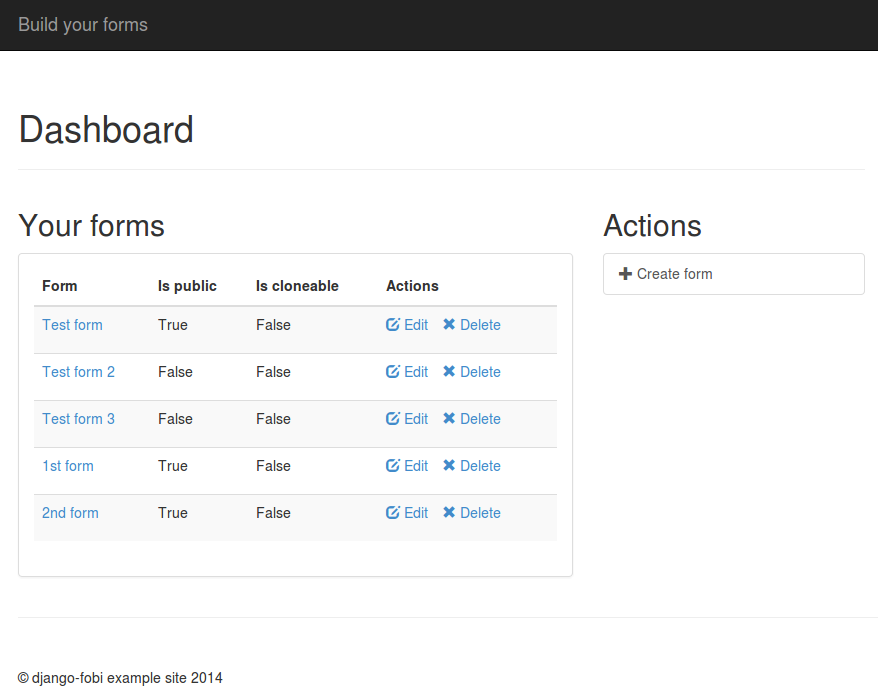
Create a form
Create a form
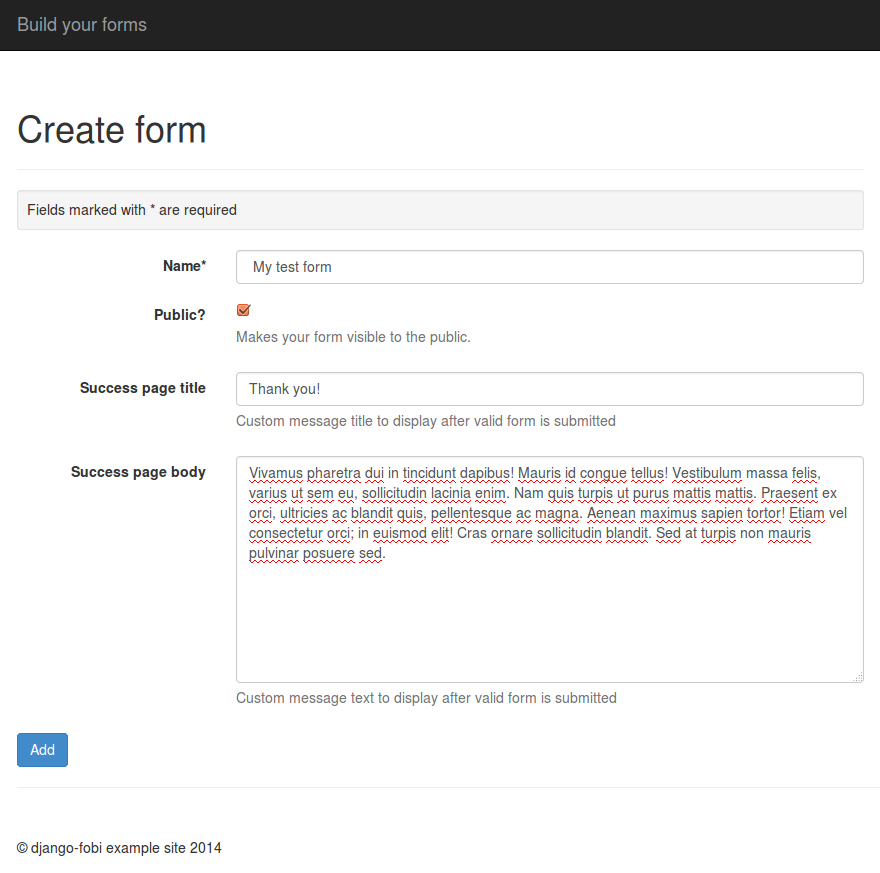
View/edit form
Form elements
Edit form - form elements tab active, no elements yet
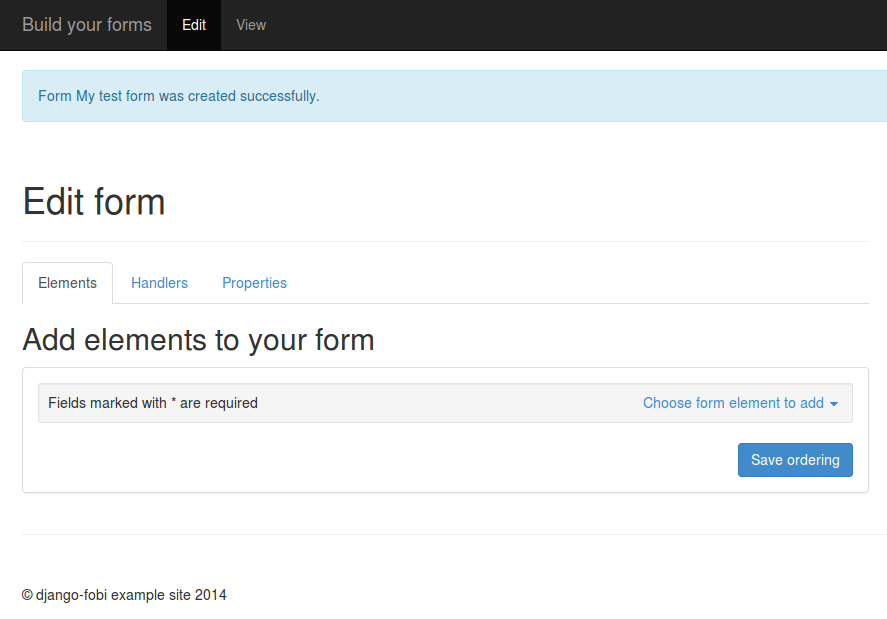
Edit form - form elements tab active, add a form element menu
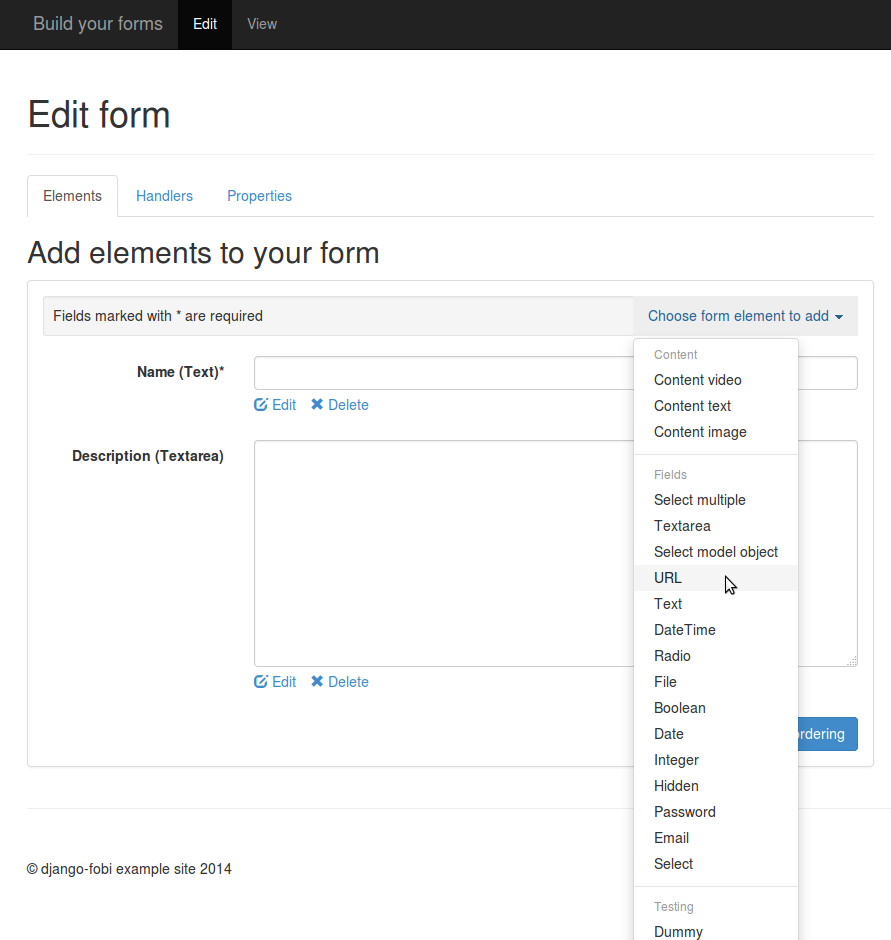
Edit form - add a form element (URL plugin)
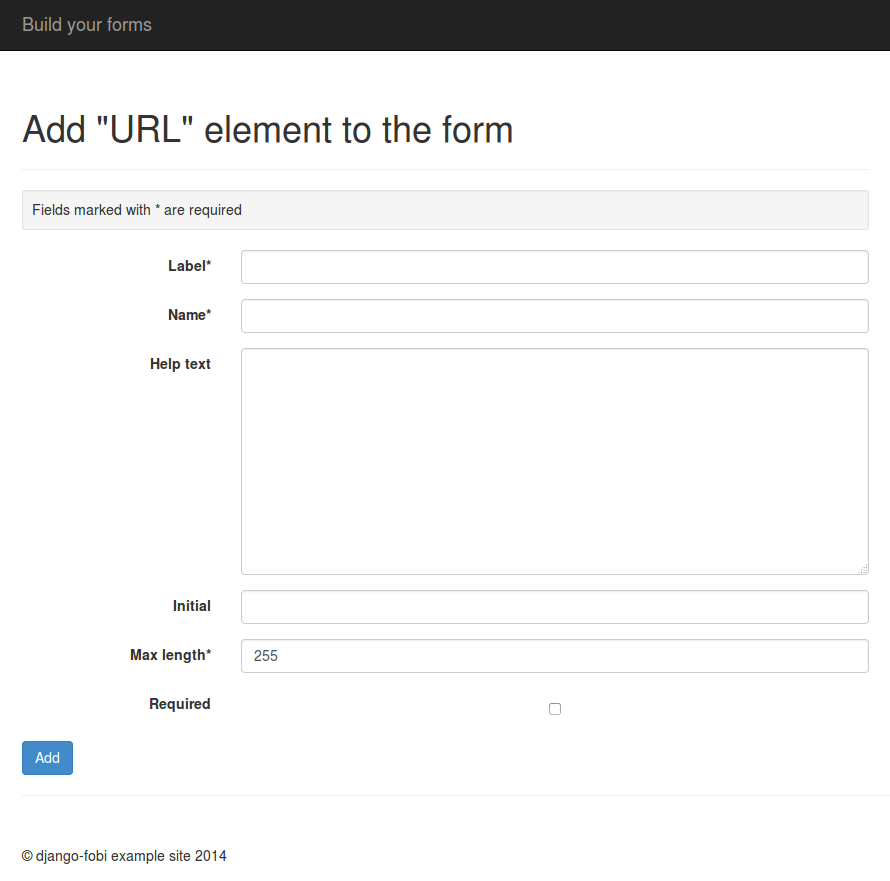
Edit form - form elements tab active, with form elements

Form handlers
Edit form - form handlers tab active, no handlers yet
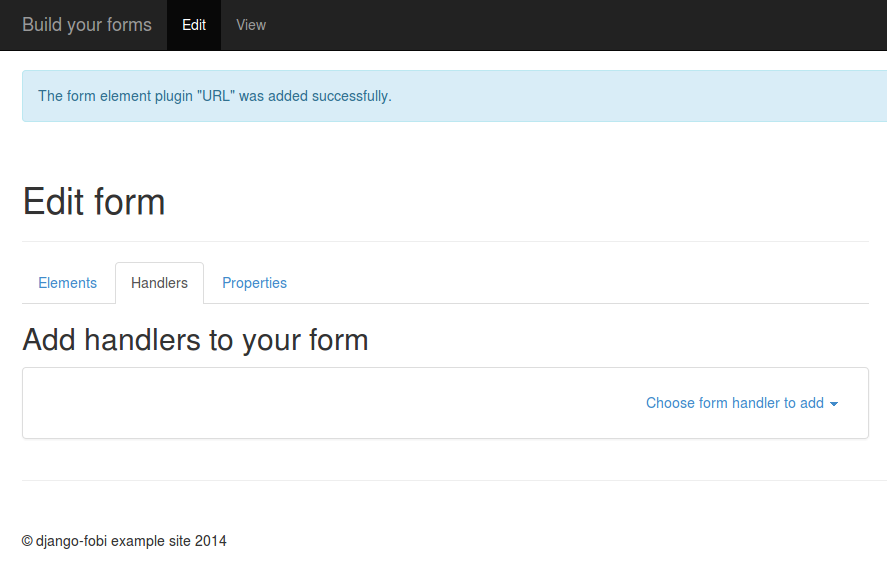
Edit form - form handlers tab tactive, add form handler menu
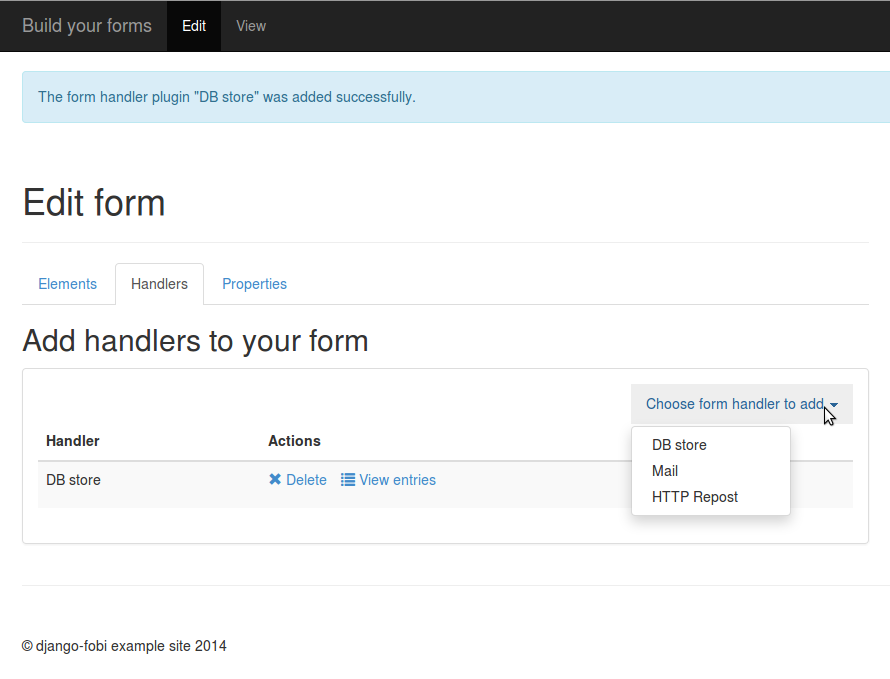
Edit form - add a form handler (Mail plugin)
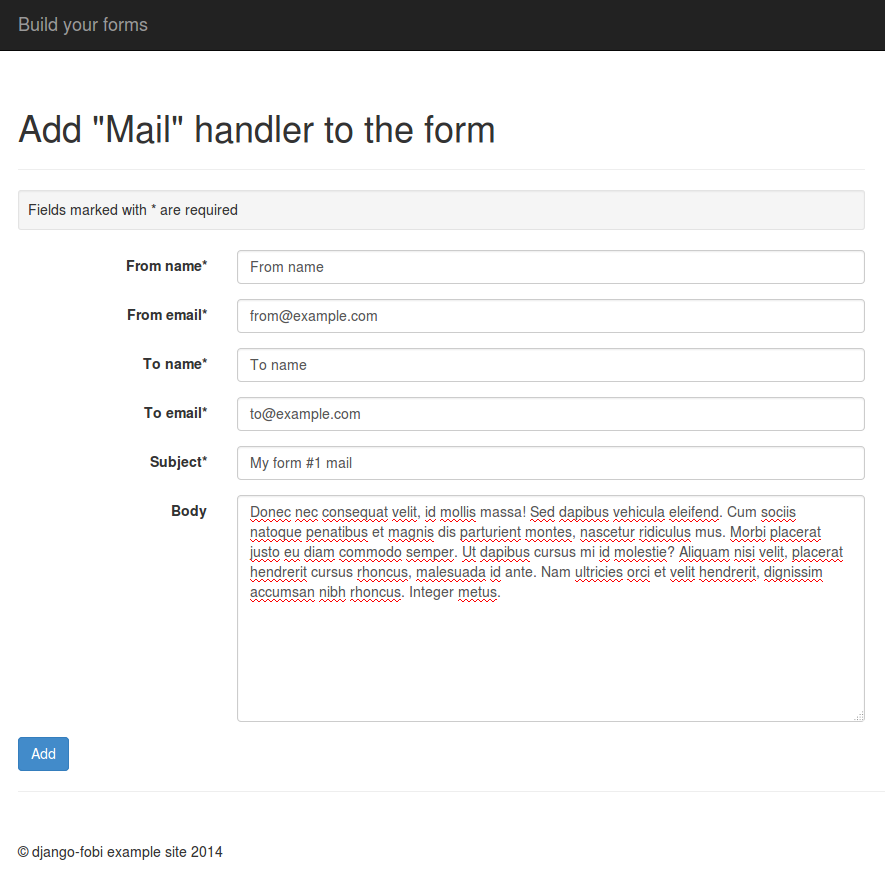
Edit form - form handlers tab active, with form handlers
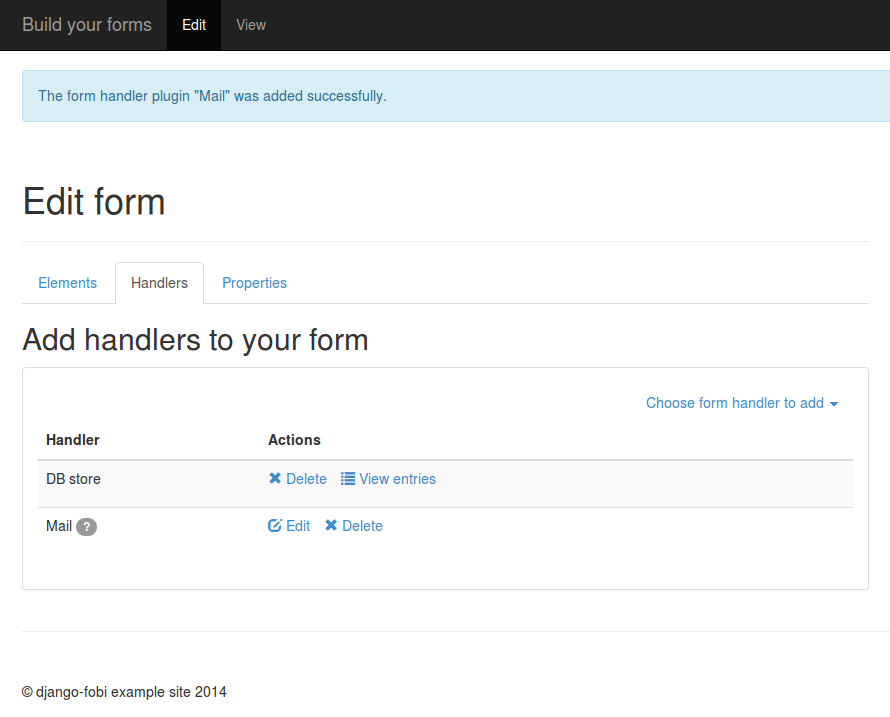
Edit form - form properties tab active
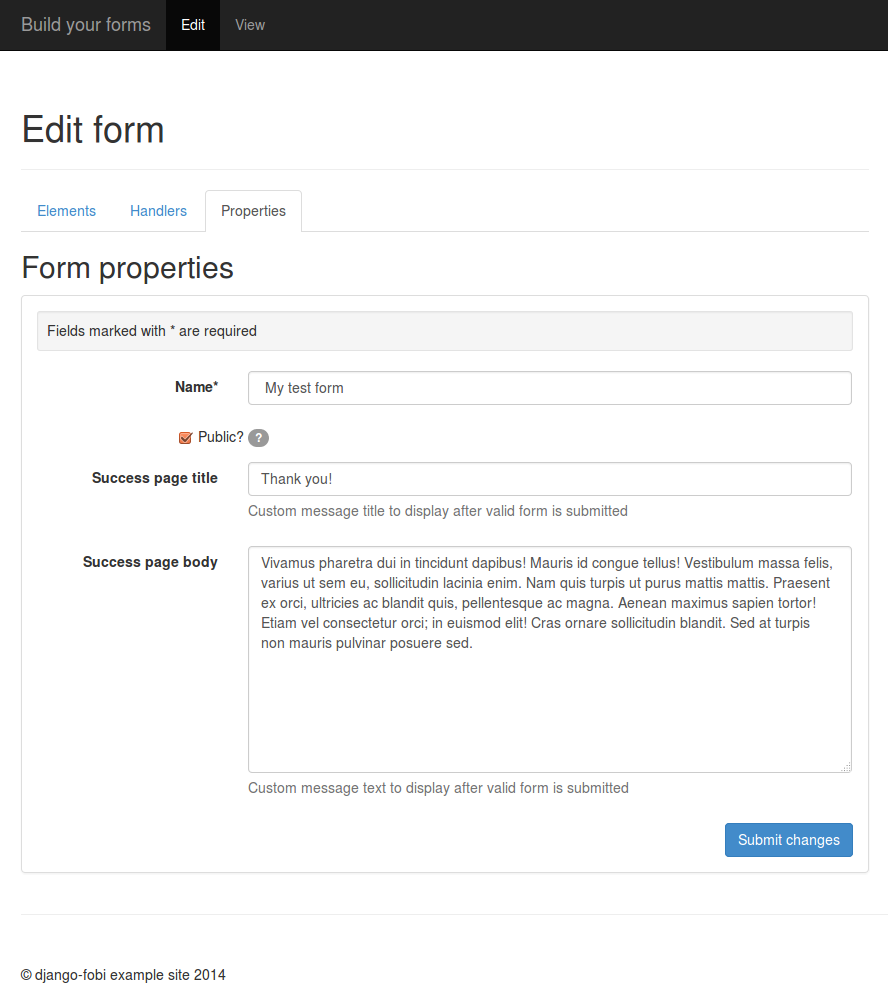
View form
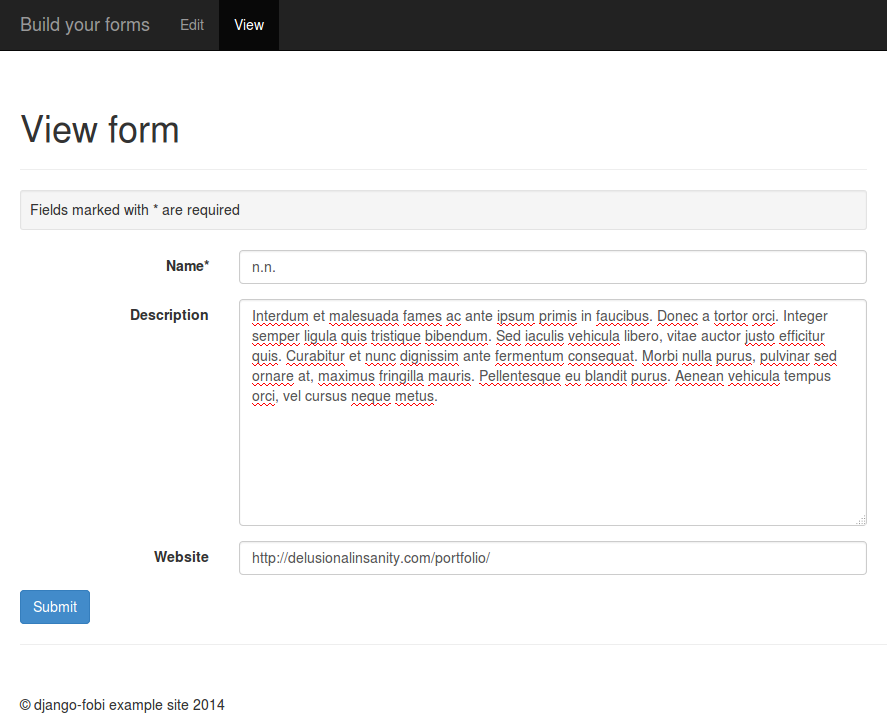
View form - form submitted (thanks page)
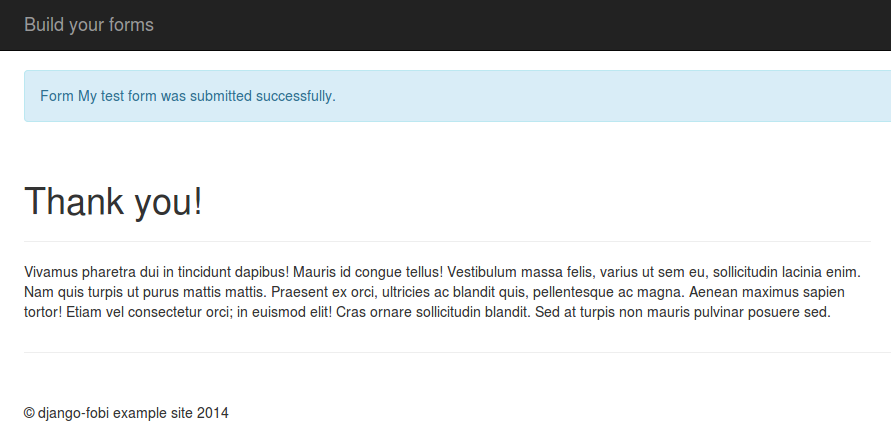
Edit form - add a form element (Video plugin)
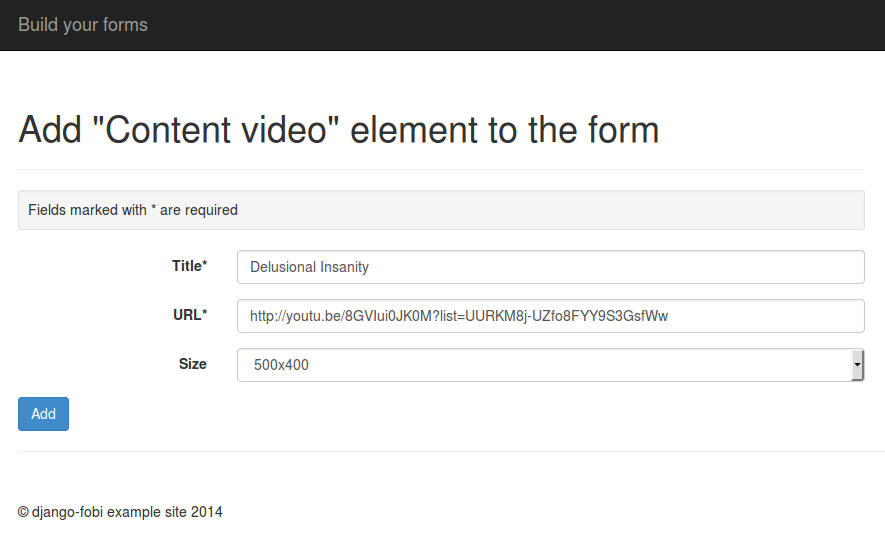
Edit form - add a form element (Boolean plugin)
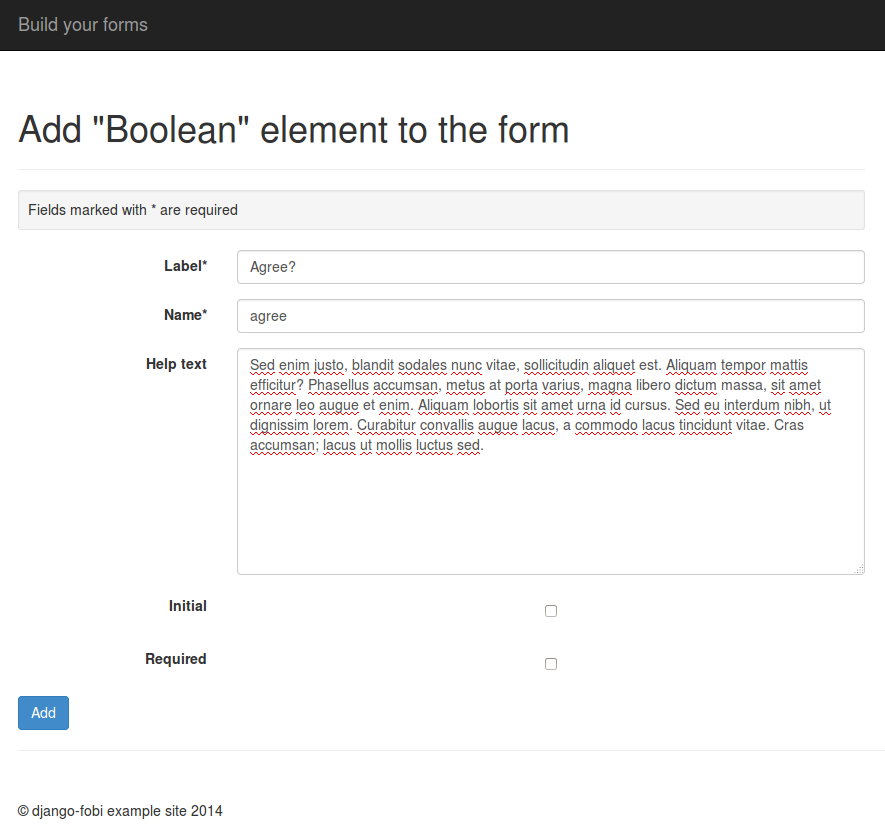
Edit form
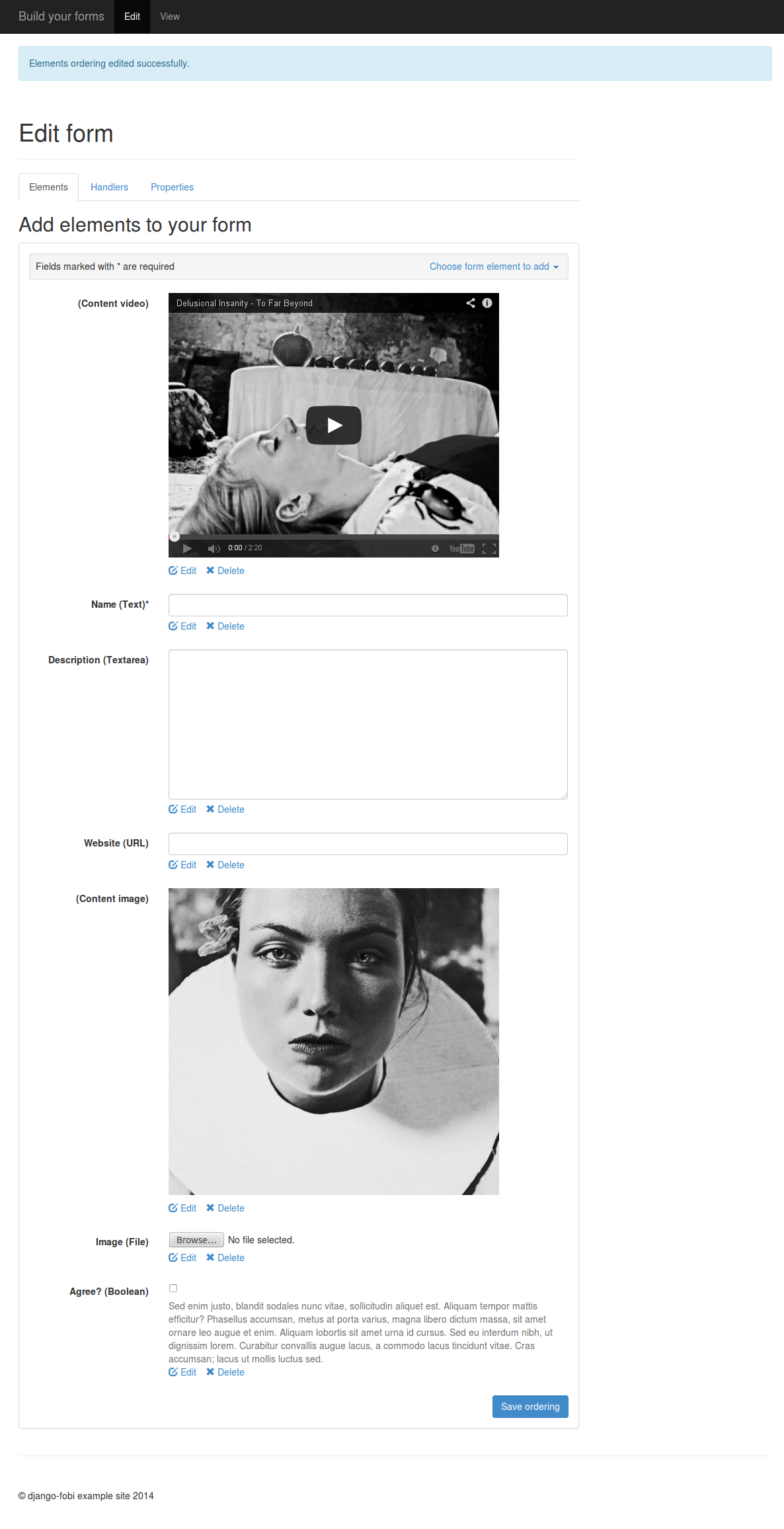
View form
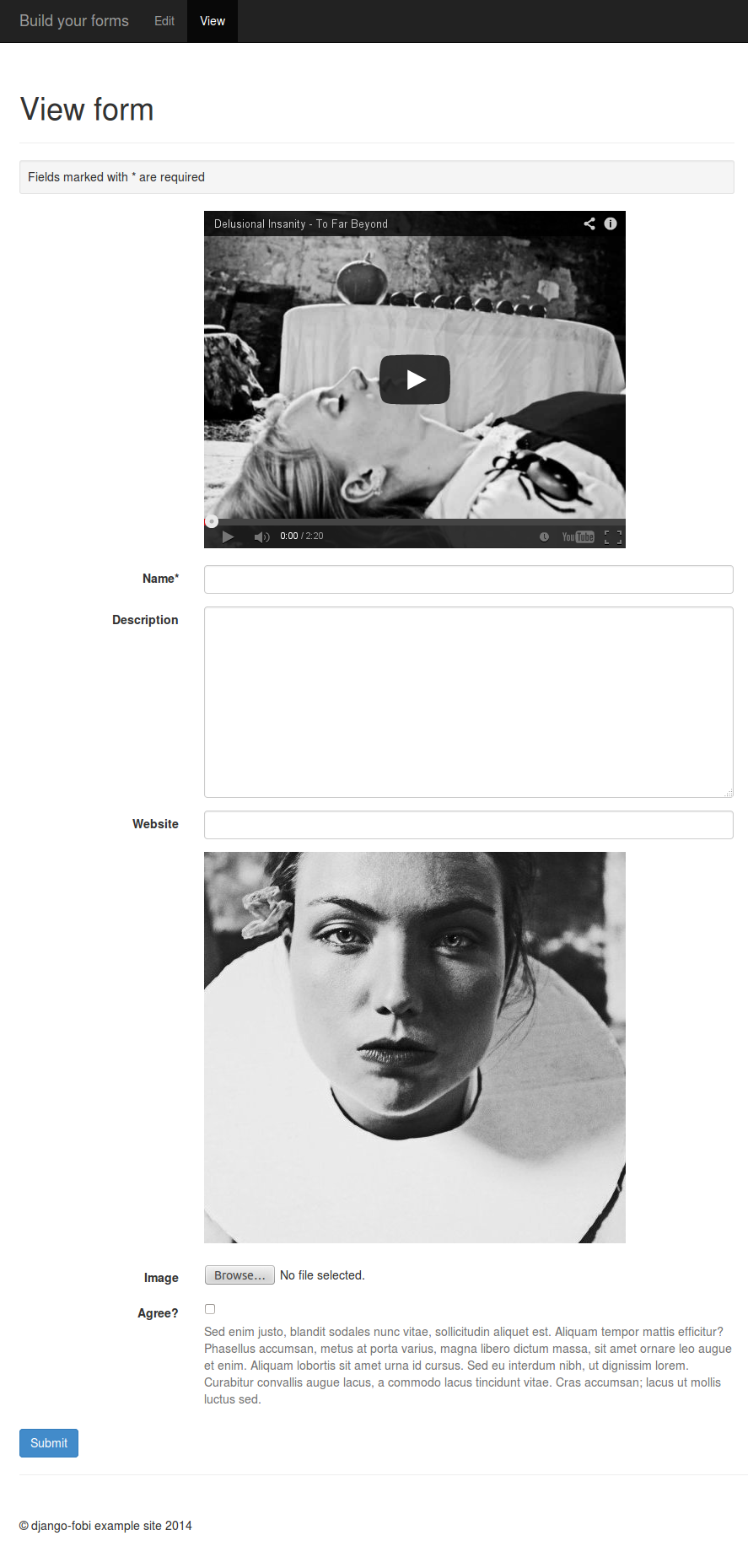
Simple theme
View/edit form
Edit form - form elements tab active, with form elements
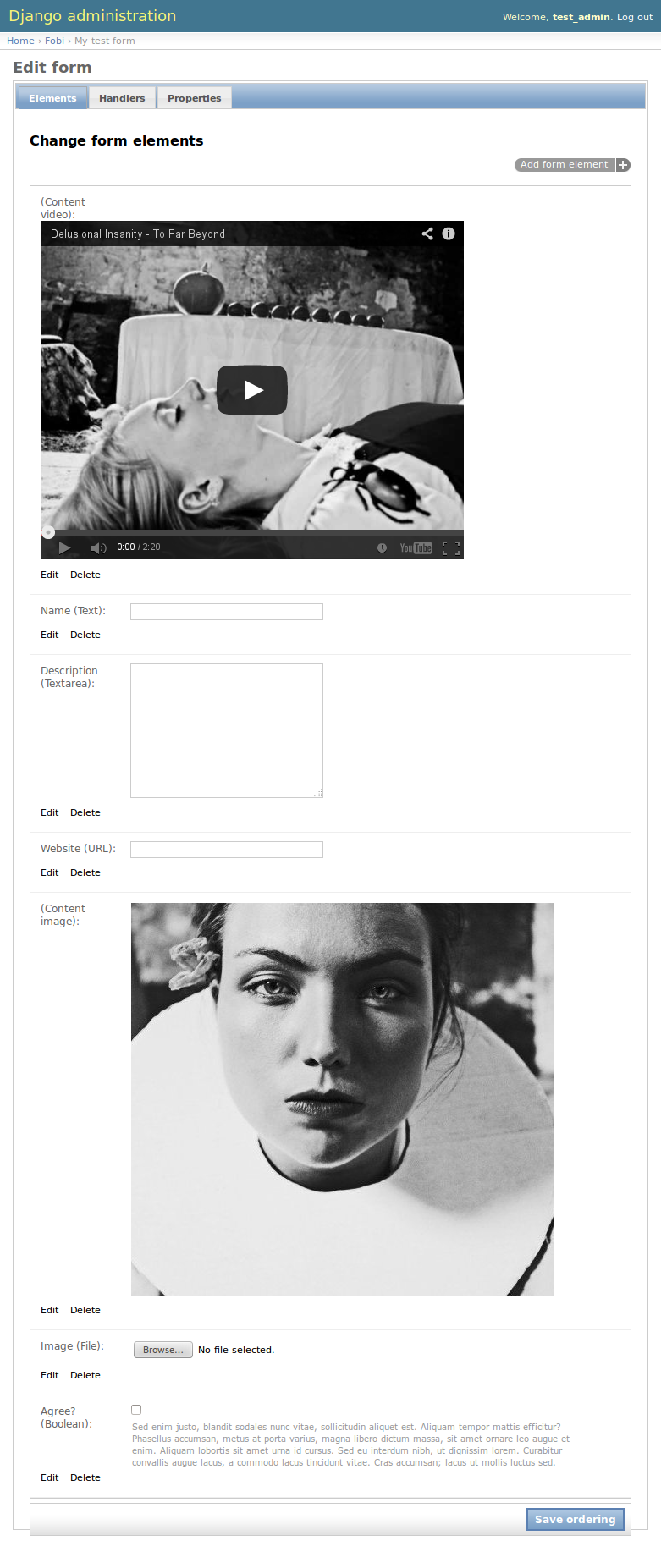
Edit form - form elements tab active, add a form element menu
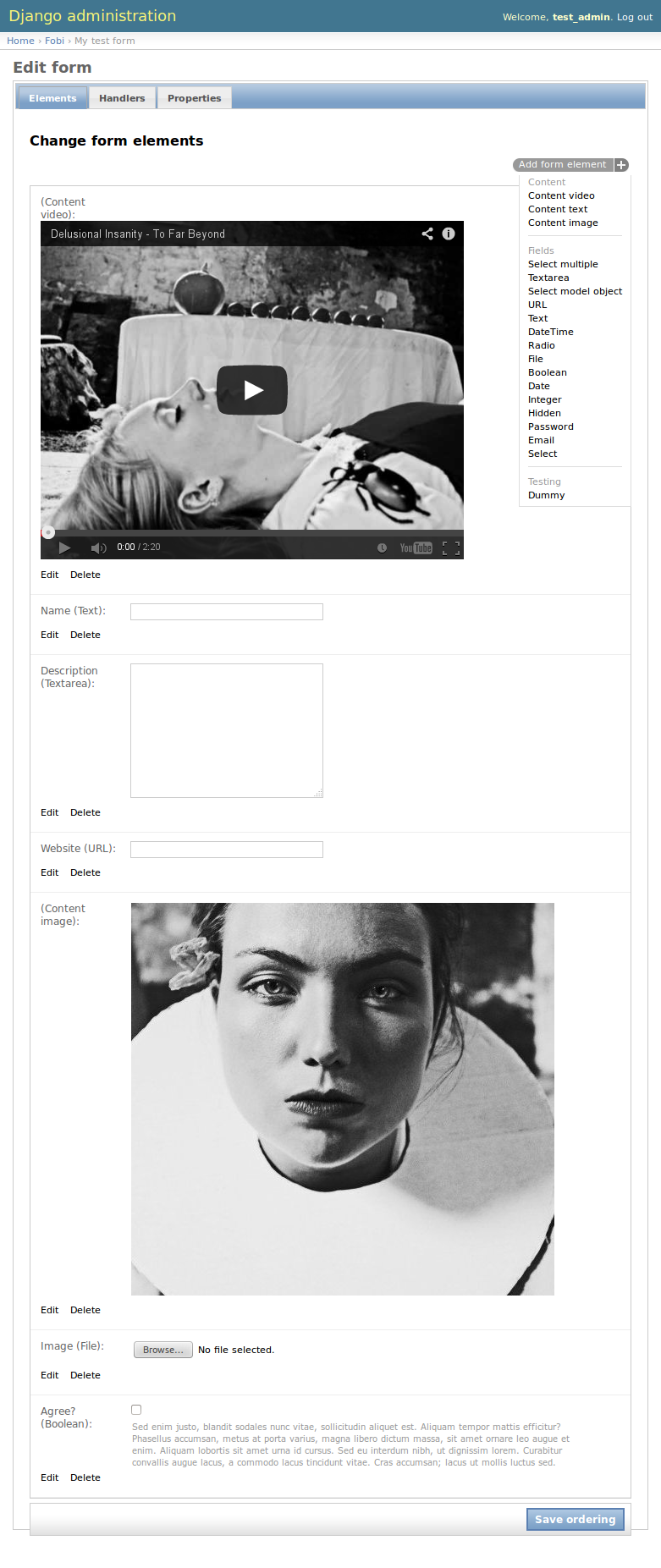
Edit form - add a form element (Hidden plugin)
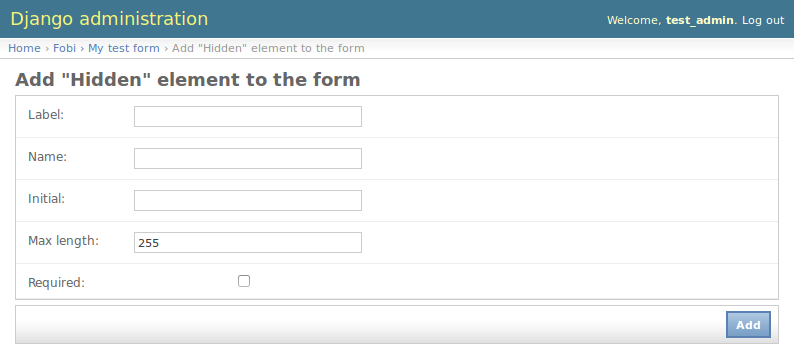
Edit form - form handlers tab active, with form handlers
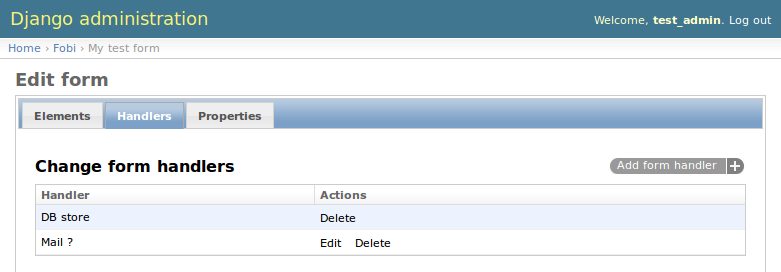
Edit form - form properties tab active
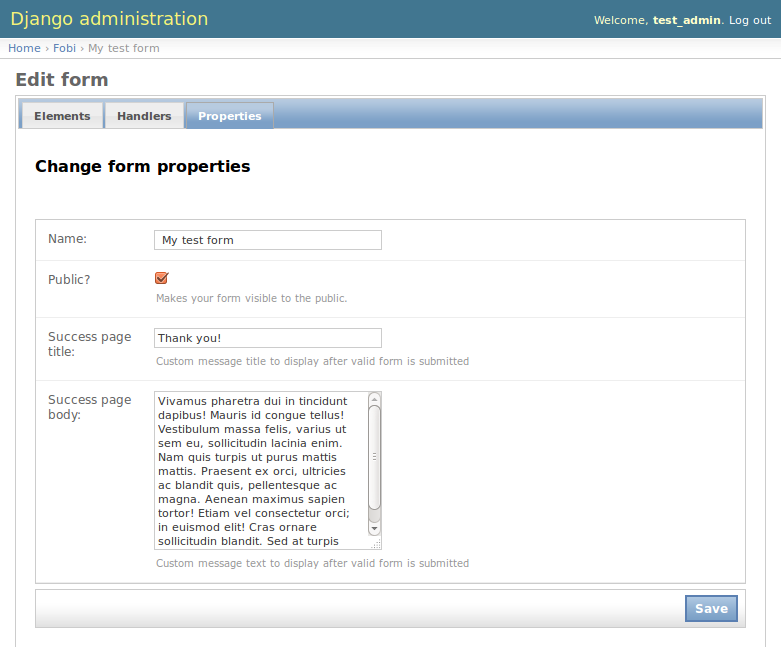
View form
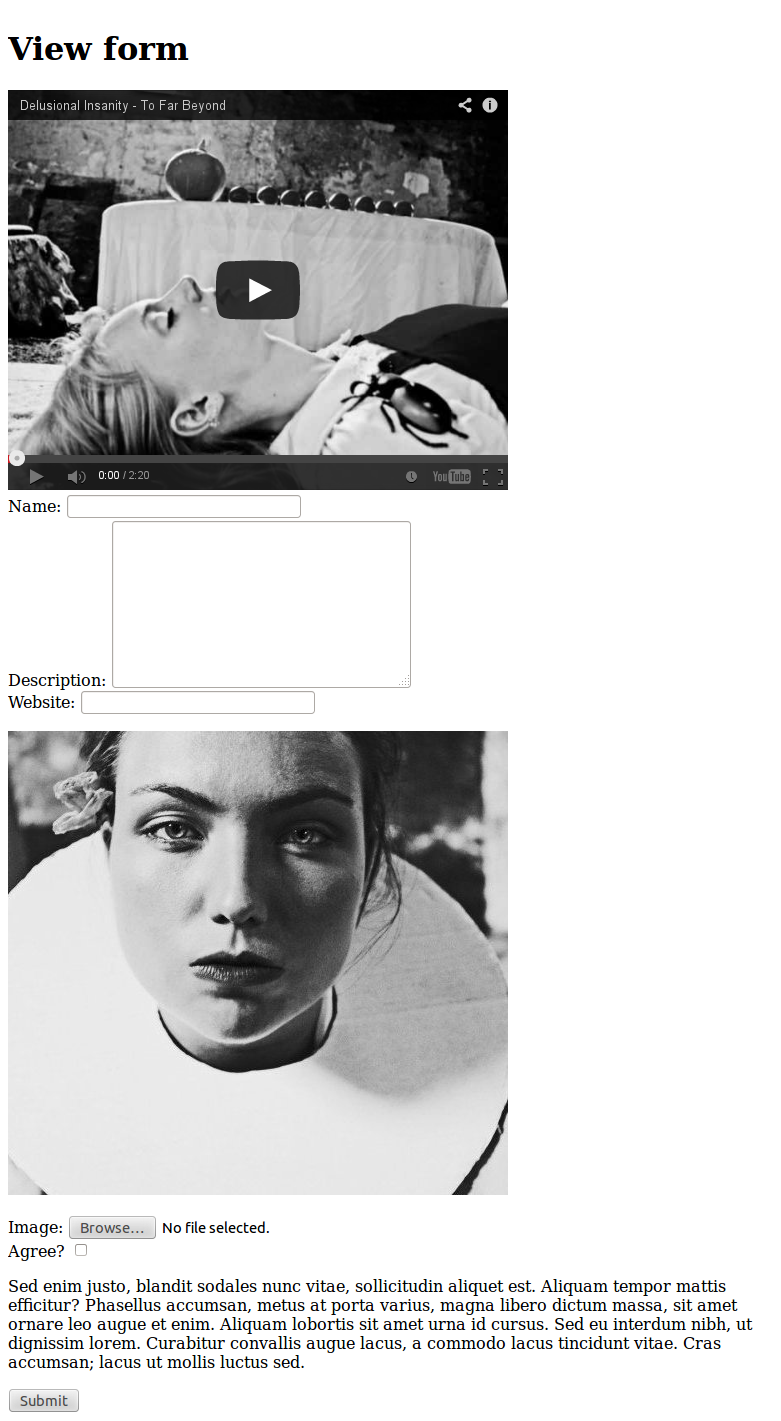
Project details
Release history Release notifications | RSS feed
Download files
Download the file for your platform. If you're not sure which to choose, learn more about installing packages.
Source Distribution
Built Distribution
Hashes for django_fobi-0.19.9-py2.py3-none-any.whl
| Algorithm | Hash digest | |
|---|---|---|
| SHA256 | ee64a38717d4cd67a077b66b2356da1f37d9bf889670d49aebb731c7cc2df5c3 |
|
| MD5 | a081135d3b06037a0d1f1f2af79c8eff |
|
| BLAKE2b-256 | 26bc800337ceb5a120ed9ca4d91f085517bf6a317e28e15838a9f91a0e2d33e3 |











